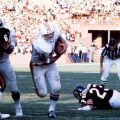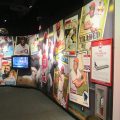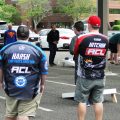JerseyMan

Precision Pistol – Shooting For Greatness
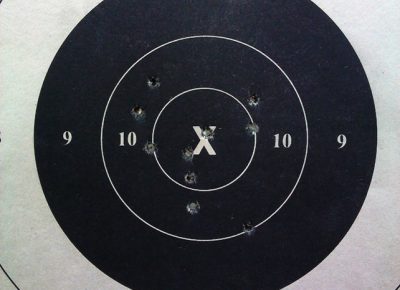
Precision Pistol shooters are phenomenal at focus…it’s quite a feat to be able to consistently nail an eight-inch wide target from 50 yards. JerseyMan sent me to cover the annual State Outdoor Pistol Championship for the December 2015 issue. I learned some amazing stuff. You can view the PDF of the magazine article here.

New Jersey’s top marksmen, shooting for nothing but excellence.
Precision Pistol Shooting For Greatness
“It’s the ultimate badass sport with pistols.”
At the end of “Rocky III”, Apollo Creed challenges Rocky to a rubber match between the two of them…to settle the score of who is the best, once and for all. As Apollo explains to Rocky, it’s only to prove it to himself…“no TV, no newspapers, just you and me.”
Because in the end, that is all that matters to a true competitor, at any level. Self-respect.
Rich Kang, a surgeon from Maryland, has had his picture added to the New Jersey Pistol website, as the Winner of the 2015 State Outdoor Pistol Championship. His name is now engraved on the Madore Trophy.
And that’s pretty much the extent of his recognition for this exceptionally difficult achievement. The top result of a Google search for “Rich Kang” is the LinkedIn profile of a California product developer with the same name.
Precision Pistol excellence isn’t something one pursues for stardom, applause or financial gain. There wasn’t much in the way of an audience or media…other than a lanky, curious writer for a popular men’s magazine…present at the championship event. Shooter Frank Greco likens it to golf: it may not be the most exciting spectator sport, but among participants, there is an unwavering admiration for the best.
“It’s the ultimate badass sport with pistols. In the shooting world, badass is snipers,” he says. “In the pistol world it’s precision shooters.”
Greco is the Regional Vice President of New Jersey Rifle & Pistol Clubs, based in Highland Lakes. A portion of this event took place at the Central Jersey Rifle & Pistol Club in Jackson. Greco didn’t participate in the competition, but he was there to explain the mystique of it, right down to the effect of donut consumption on shooters. True.
“The sugar raises the blood pressure and affects the steady hand,” Greco says, while offering a donut to this observer. “Sugar and caffeine in excess can be Kryptonite to a shooter.”
It’s that demanding?
To say the least.
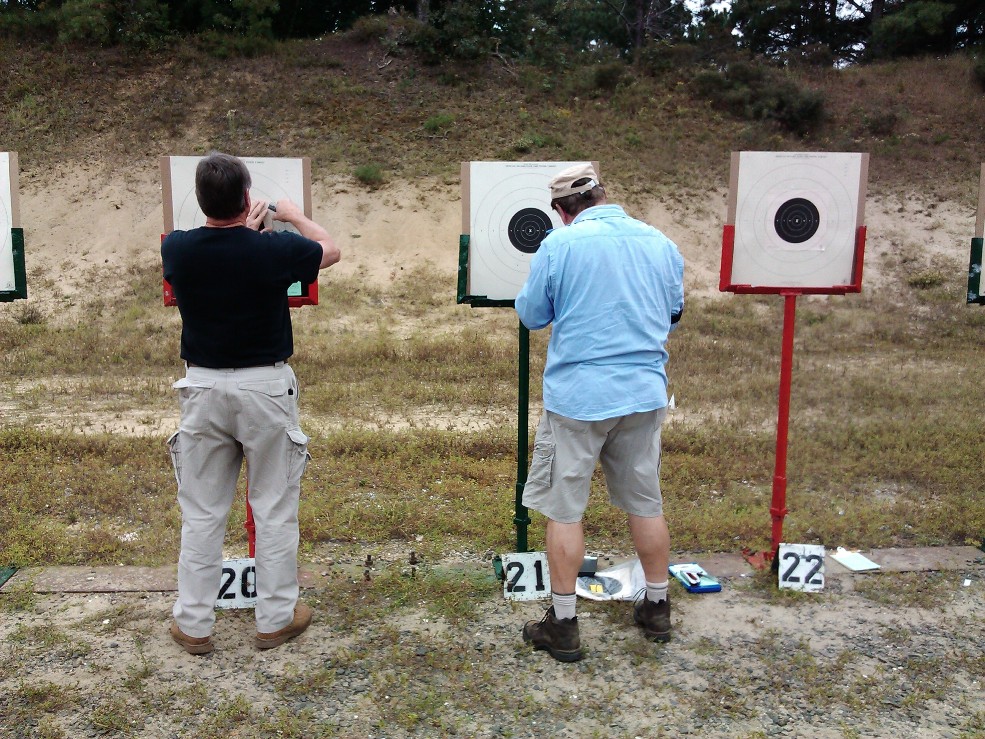
Could you hit it from half a football field away?
Picture how far 50 yards is. 150 feet. Half of a football field. Now fathom being able to steadily aim and fire a pistol from that distance and consistently hit a target eight inches wide.
That’s just for an eight-point shot. For a 10-pointer, that target is just three inches wide; for a bull’s eye…which is used as a tiebreaker if two shooters have the same score…it is just an inch and a half.
Can that even be done with normal human vision? Yes, and the shooters on the firing line this day are proving it. With multiple types of firearms and various types of shooting…moving targets, rapid fire, timed firing.
It’s a three-gun match, with .22, centerfire and .45 caliber pistols. With each type of pistol, a shooter takes 90 shots. Those 90 shots are broken down into four matches: Slow Fire is two strings of ten shots each over ten minutes; National Match Course is ten Slow Fire shots, followed by two strings of five shots each at 25 yards; Rapid Fire is two strings of five shots each over ten seconds; and the Timed Fire Match is four strings of five rounds each, with 20 seconds per string.
All day long, the barrage goes on. Casings litter the ground. Wisps of dust float from the dune behind the targets. The unmistakable odor of gunpowder fills the air. Wrists snap back in recoil with larger pistols. The noise is thunderous and deafening at times, but that’s the only aural distraction allowed. No talking or other sounds behind the line. During one match a ringing smartphone is immediately shut off; only in church could that be more embarrassing.
It’s grueling, this full day of shooting. Comfortable footwear is a must.
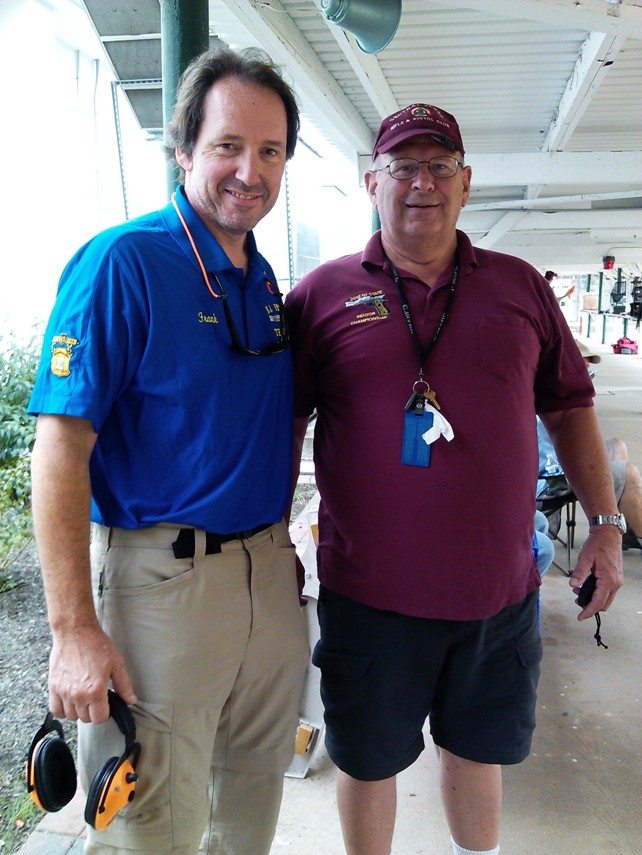
Frank Greco (left), with Ed Glidden (right), the director of the match.
Between rounds a horn sounds and a red light begins flashing. When the light is flashing, guns must be down, and must remain untouched until the flashing stops.
Ed Glidden, the director of the match, calls out instructions to the shooters, obviously with safety as the top priority. Cease fire, magazines out, make the firing line safe. Empty chamber indicators installed. Check your gun; check your neighbor’s gun. And so on, dozens of times. Glidden’s role looks boring to someone witnessing the action. But needless to say, it’s an essential one.
Part of Glidden’s occupation is training shooters in gun safety, including teaching youngsters in the club’s highly touted junior program. “Individual training,” he says, “is keeping the gun pointed in a safe direction at ALL times and treating every gun as if it were loaded. Constant awareness of the range officers and other shooters, to prevent and/or correct the slightest infraction until safety becomes a habit. Any unsafe practice will result in expulsion from the match and the range.”
The Central Jersey Rifle & Pistol Club people have a reputation for their focus on safe handling of lethal weapons. They are frequently praised for it in online reviews. It is particularly impressive to see younger people on the firing line, some barely in their teens, completely comfortable handling firearms. Partly because of Glidden’s repetitious direction, safety is second nature in this competition.
Besides, with the concentration required at tournaments like this, competitors have more than enough to occupy their minds.
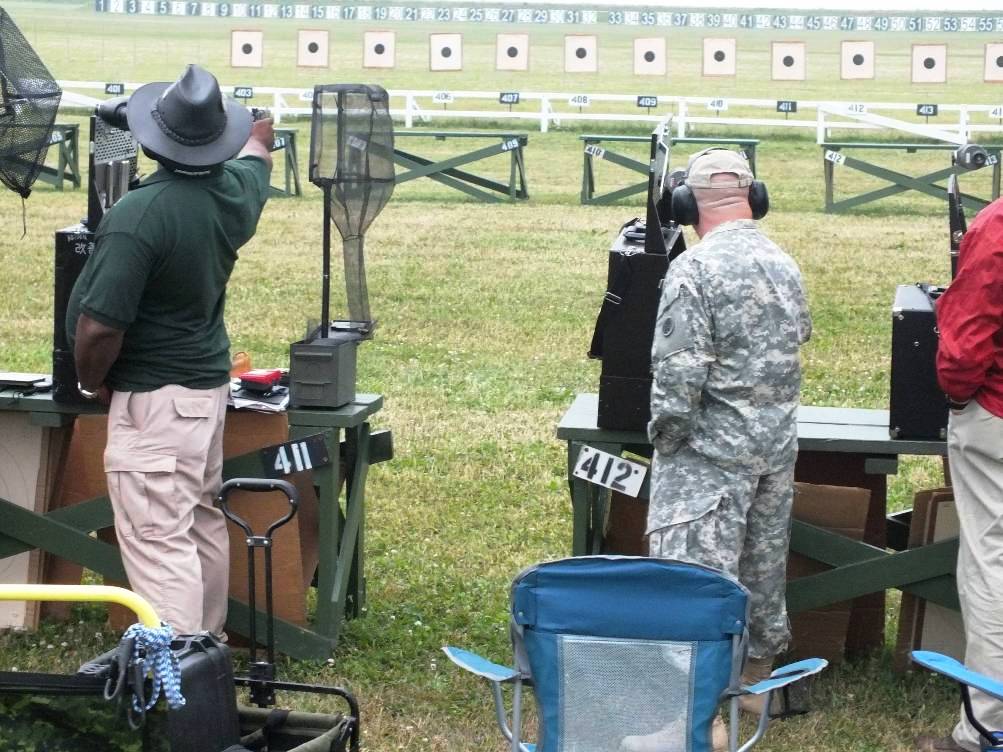
Lateif Dickerson (left), who has forgotten more about self-defense than most of us know. (photo courtesy of Lateif Dickerson)
Watching the shooters it appears as though they are cool as ice, with the focus, the concentration, the steady hand. But as one of the better shooters on the line can tell you, it takes years to develop this composure. And even he still grimaces at the occasional subpar shot.
Lateif Dickerson is the master instructor at the New Jersey Firearms Academy. His resume of other titles is very impressive: Certified Pistol Instructor, Range Safety Officer, Combat Handgunner at the School of Defensive Firearms, the list is long. He’s been training civilians, police and military for 19 years in various weapons usage and self-defense.
Dickerson can tell you a bit about becoming adept enough for this competition. There are three stages, he says…know how, physical conditioning and mental conditioning.
Know how is mastering the fundamentals… like stance, breath control, and recoil management. Stance “should be as comfortable but as stable as possible. Think like a crane; your legs are the outriggers, your arm is the boom.” Breath control is “basically holding long enough so you aren’t moving.” Recoil management is the ability to “consistently recover to the same place when shooting.”
Then there’s the physical conditioning.
“A match can go from 9:00 AM – 4:00 PM, or longer. If you start fatiguing during a match your performance will fail. You must be able to hold the weight of your arm and gun up all day – and steady. Holding steady requires an isometric tension that needs to be developed also.”
But the mental preparation is by far the toughest part.
“The ONLY thing that should exist in your mind is that your sight is where it’s supposed to be as the trigger moves rearward…this is very hard. We all have a lot of noise and distractions, so conditioning your mind to focus is a process. That process is largely the challenge in shooting.”
Frank Greco emphatically agrees, sharing a story of his own self-defeat in the mental aspect of the game.
“When you’re in it, on the line, loading, in the zone, improving your score, it’s incredibly intense and extremely difficult mentally.
“One of my first times I experienced the ‘mental game’ was in the NY State Championship. The match director came over to me and asked me if I knew I was shooting better than most of the Experts and Masters. I said no, and got accidentally sidetracked, thinking I was going to win the match. The lost focus immediately showed; my shots were random and my scores went down.
“It’s vital to maintain a positive outlook and to speak to yourself in positive statements. It’s important to train your subconscious mind and create a positive self-image.”
He pulls out his smartphone and shows this observer a picture of a target, the high-value section of it riddled with bullet holes. Sometimes, he says, he needs to look at it during a match, to remind himself what he’s capable of.

The trophy is just a bonus.
It’s all undeniably worth the effort.
The true reward of Precision Pistol, as Greco relates from his own personal experience, is self-respect…the realization of one’s hidden abilities and the ability to meet the most difficult of challenges. Once a person can hit that one-and-a-half inch bull’s eye from half of a football field away, it’s hard to imagine how monthly bills could faze them.
“Great shooters have an almost Zen-like approach to shooting and how they approach their daily lives, jobs, etc. Since I started, my ability to focus has sharpened dramatically, and it’s positively benefited other areas of my life. The ability to focus on what matters, and disregard unimportant matters, literally frees your mind.
“The benefits are real, and to that extent, shooting has made me a better person.”
Did learning about Precision Pistol shooting make your day a little bit?
I hope so. If it did, I would really appreciate your support.
When you use this link to shop on Amazon, you’ll help subsidize this great website…at no extra charge to you.
Thanks very much…come back soon!
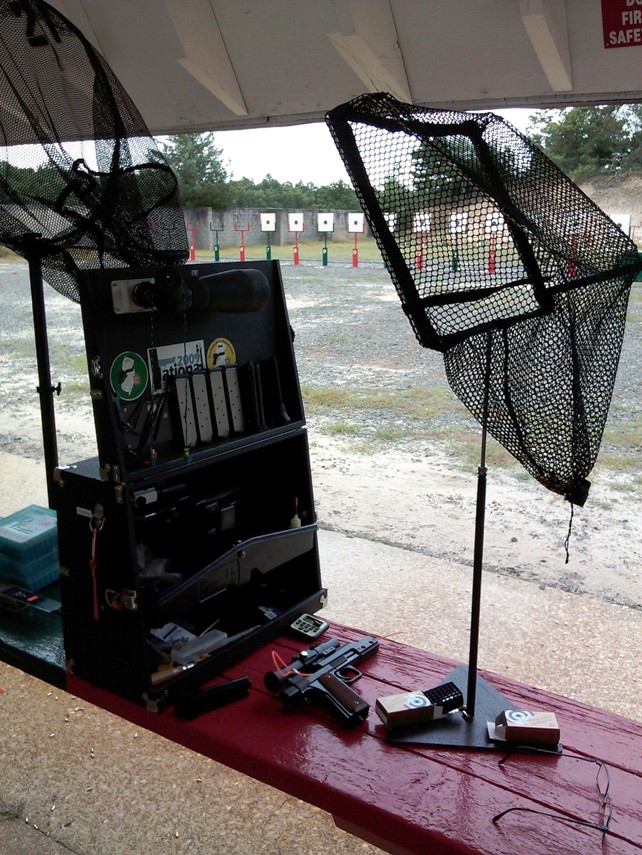
Choosing the right equipment is essential, especially with the cost outlay.
Get Started With Precision Pistol Shooting
If you’d like to try Precision Pistol Shooting, there is a website dedicated to helping you get started, with several informative pieces from top shooters. The site is called “The Encyclopedia of Bullseye Pistol”.
Among the articles is a piece by site owner John Dreyer about essential equipment. There’s a lot to know when laying out the considerable funds for pistols…like whether they are mass-produced or hand built, or the differences between high performance and convertible pistols. Not to mention other necessary equipment, like eye and ear protection, scopes and cleaning supplies. Pistol shooting is not a cheap sport, so spend wisely.
Another piece by Dreyer quotes several Zen philosophies and describes the achievements in pistol shooting in how they relate to such quotes. One example: “A man who has attained mastery of an art reveals it in his every action.” Dreyer compares this to pistol shooting in the sense that once a shooter can sustain an “empty mind”, he can see “underlying principles in everyday life and life in all things”.
Another piece from top shooter Jake Shevlin reveals the “secret” to shooting high scores. It’s the same secret one learns about how to get to Carnegie Hall…practice, practice, practice. The shooter must sacrifice…sacrifice time, money, convenience, and priorities in life to excel at just one thing. Top marksmanship requires a level of commitment unmatched by few endeavors. That, says Shevlin, is the “secret”.
The Encyclopedia of Bullseye Pistol website also features a discussion group, e-mail updates, and links and maps to shooting clubs and ranges.

Try it without ammo until your scores improve.
Multiple Champion Dave Lange on Dry-Firing
Dave Lange’s name appears a lot on the NJ Pistol website. He has won the overall state outdoor championship nine times since its inception in 2001; the only other shooter who has won it more than once is Ron Steinbrecher, who has captured the title just twice. Lange was also the NJ resident champion in 2015, though he lost the overall title to Rich Kang.
Lange is the author of a piece for Shooting Sports USA, linked to the NJ Pistol website, detailing the benefits of dry-firing…firing a weapon without ammunition. With dry-firing, a shooter can focus on weaknesses, like maintaining consistent grip. Lange states in the piece that he practices his dry-firing three times a day, 15 minutes each time.
With dry-firing, a shooter can run a mental program through his mind of executing a successful shot; Lange’s program involves picturing a red dot in the center of the bull’s eye and then picturing the bull’s eye with the bullet hole in the center.
Dry-firing can address any shooter’s specific problem, Lange says. The key is being willing to commit to it until a shooter’s scores improve. Given his success, he’s probably got a point.
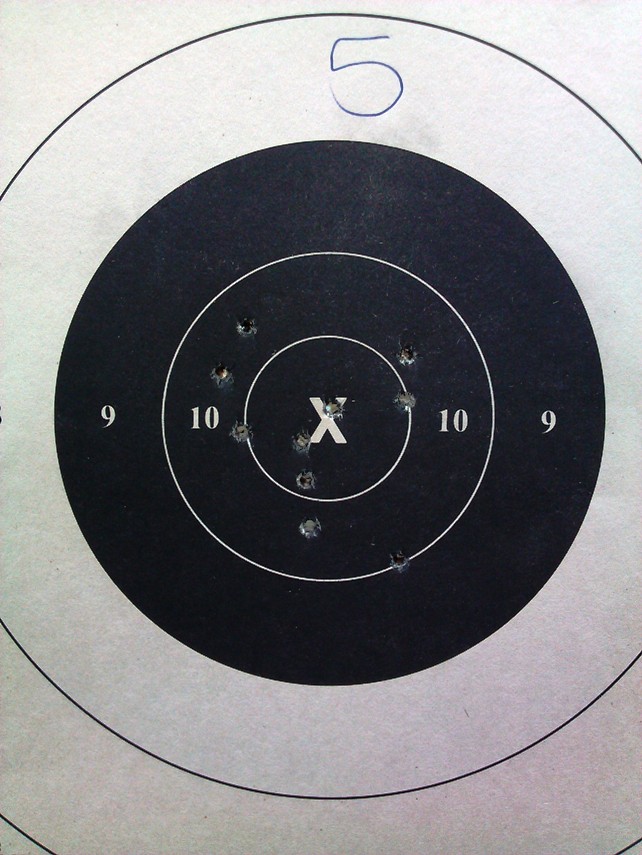
Phenomenal for most of us mortals. Nowhere near good enough to be a national Precision Pistol champ. (photo courtesy Frank Greco)
The Best in the Nation
The NJ State Outdoor Pistol Championship, according to Frank Greco, is the 3rd largest of such events in the nation; the national event, known as the “World Series of the Shooting Sports”, takes place in Camp Perry, Ohio, 40 miles east of Toledo. Events have been held there since 1907.
The overall National Pistol champion for 2015 is Keith Sanderson from Colorado Springs. He scored an incredible 2,655 points out of a possible 2,700. Second was Brian Zins with a score of 2,641. Sanderson is an Olympic gold medalist; Zins was the 2007 NJ State Champion.
To put those scores into perspective, do the math: 2,655 divided by 270 shots equals an average shot score of 9.83…so Sanderson’s average shot was almost always in that three-inch range for ten points, with maybe one or two in a hundred falling outside of it for a nine-pointer.
The difference between Sanderson’s and Zins’ score was just 14 50-yard shots out of 270 that covered a five inch range instead of three.
One wonders if Zins thought about having a donut the week before the match.

The Power of Fun – Dave Raymond, The Original Phillie Phanatic

The Phillie Phanatic is the greatest mascot in sports…largely because original Phanatic Dave Raymond simply put on the costume, went out and had fun. I had a chance interviewed Dave, who now creates team mascots as the owner of Raymond Entertainment Group, for the April 2015 issue of JerseyMan. You can view the PDF of the magazine article here.

Dave Raymond, the original Phillie Phanatic, with his best friend. (photo courtesy of Dave Raymond)
The Power of Fun
Imagine being a business owner who is looking to improve your marketing. You want a smart, polished, exciting campaign to bring life into your adequate but unmemorable image. You want to target a younger audience that otherwise might not discover your product.
Needless to say, this problem requires professional expertise, so you call in a consultant.
A consultant who, for much of his adult life, made his living wearing a furry green costume, recklessly riding around in an ATV and thrusting his ample hips at sports officials.
Because if your company is a minor league baseball team, and the idea is to bring more kids to the ballpark, and you want to create a mascot on that basis, hiring the original Phillie Phanatic to handle the design is a no-brainer.
As the man behind arguably the most beloved mascot in sports, who today is the “Emperor of Fun” at Raymond Entertainment Group, Dave Raymond understands the marketing value of a fun diversion.
Even if he learned it by accident.
“The joke was that the Phillies got the kid that was stupid enough to say yes,” Raymond says with a laugh. “I was a student at the University of Delaware. I had my fraternity brothers telling me, ‘they’re gonna kill you, they’re gonna hang you in effigy and set you on fire, and that’s when the Phillies win! When they lose you’re really gonna get in trouble!’
“That first day, I went into Bill Giles’s office and said, ‘Mr. Giles, what do you want me to do?’ A smile came across his face and he said, ‘I want you to have fun.’ I was tearing out of his office thinking, ‘Wow, this is going to be easy,’ and he screamed, ‘G-rated fun!’
“The first night I fell over a railing by accident, and people laughed. So I was thinking, I have to fall down more. Slapstick humor was something I loved, I was a Three Stooges fan, I watched all the cartoons. It was Daffy Duck and Foghorn Leghorn and Three Stooges because that’s what they laughed about.”
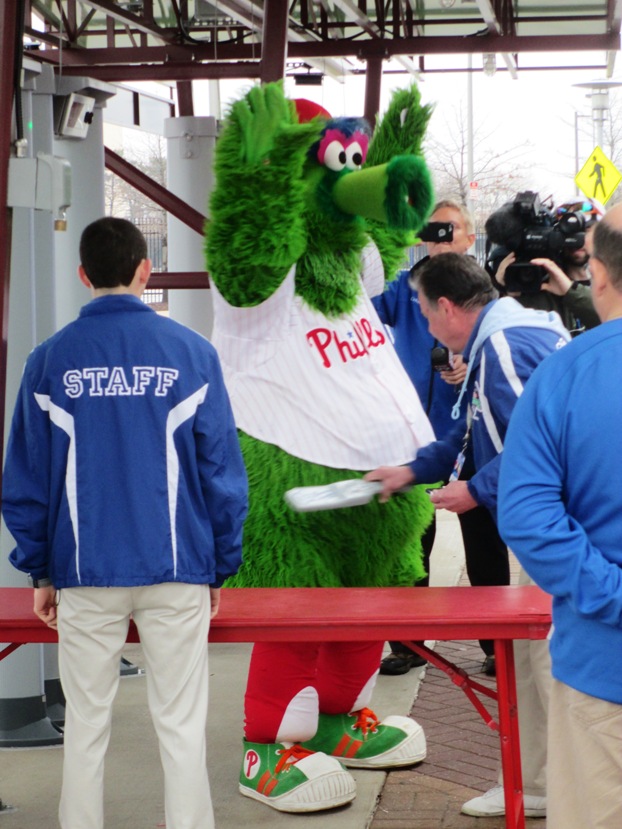
The Phanatic is also always willing to set an example for fellow fans.
Dancing with the grounds crew quickly caught on, too.
“The first night I did that, I tripped one of the guys by accident, the kid tripped and fell, and people laughed. That turned into me running around the bases and at each base I would knock one of the kids over, and then we would all gather behind home plate and dance. Fans were giving us standing ovations, because they’d never seen the grounds crew animated!”
In a rabid and brutally unsentimental sports town, it also didn’t hurt that the Phanatic could so effectively taunt the opposition. Tommy Lasorda, who could often be described as a cartoon character himself, once even wrote a blog post titled “I Hate The Phillie Phanatic”.
Raymond gets along with Lasorda and has read the post. Their feud was usually friendly, but it could escalate: “One night he just snapped, and he came out and tried to beat the ever-lovin’ you-know-what out of the Phanatic.”
The two smoothed it over, but Raymond retains his proud Philadelphian perspective towards the Dodgers icon. “He’s a wonderful ambassador for baseball; the only problem with him is that he’s a Dodgers fan from Philadelphia. Worst type of traitor we could ever have,” he laughs.
“I understood the psyche of the Philadelphia fan. I was one of them! I hated the Mets, I hated the Yankees, I hated the Celtics. And the Dallas Cowboys, to this day, I see Tony Romo in a commercial about pizza and I run and turn the TV off. I knew the fans would cheer when I stepped on a Mets hat or made fun of the Dodgers. I wanted to do that, because I hated the Dodgers, and I hated the Mets!
“It was that type of thing, and you put all those together and make a cartoon character out of it.”

The man and his dream.
(photo courtesy of Dave Raymond)
Today Dave Raymond brings a lifetime of experience as a world-famous character to Raymond Entertainment Group, which designs and builds mascots for sports teams and even corporations.
REG focuses on marketing the Power of Fun. It’s not an easy trick to blend two seemingly opposite concepts like fun and business, but Raymond can speak from solid experience.
“I watched my kids become Phillies fans because of the Phanatic. They wanted to go to games because they had fun. And they learned how to watch baseball and appreciate baseball. My daughters fell in love with the players because they looked cute in baseball uniforms. And now they are not letting me leave when I want to beat the traffic. From a marketing standpoint, the Phanatic’s building baseball fans.”
So in dealing with clients, Raymond emphasizes how valuable—to their bottom line—their furry representative can be. The goofy character in a bird costume is a worthwhile business investment, and for it to pay off, it needs to be done right.
“The first thing we do is make sure they understand the difference between a kid in a costume and a character brand. A character brand is a living, breathing extension of your brand, and a kid in a costume is just that.

There’s even kids’ play areas dedicated to the Phillies’ enigmatic mascot.
“We research who they are in terms of the organization’s history, and who their community is in terms of the history. We help sketch out a back story that becomes the story of the character.
“They look at designs and they play Mr. Potato Head, they tell us what they like or more importantly what they don’t like, and then we go back and continue to draw until we get a design, we assign the copyright to that design, and then build multiple costumes for them. We help prime performers and train them.
“Also, what are you doing with the character brand? How are you rolling it out? How are you trying to get sponsorships? By the time we roll out the character, they should already know when they’re going to make all their money back, and when they’ll start making a profit.
“If they don’t do due diligence, frankly, I don’t want them as a customer. If they don’t want the best, they’re not gonna value the best.
“There are people saying I need a kid to get in my suit; right away I know that’s probably a client I don’t want. This is a character costume, it’s not a suit. It’s not a kid, it’s a trained performer. If you don’t want that, we’re not the ones for you. It’s a good thing not to waste time trying to make people buy from me. You’re not going to be able to service everybody.”
That’s not to say that REG doesn’t have a long list of satisfied clients; happy customers include the Cincinnati Reds, whose mascot “Gapper” is an REG creation, the Toledo Mud Hens, the Delmarva Shorebirds and the Phillies affiliate Lakewood Blue Claws, among many others. Raymond estimates that REG has created over a hundred characters, including at least ten for corporations.
“What separates us is that no one has the track record of success that we’ve had for not only designing and building, but also helping clients make money, drive revenue and brand, find performers and train them.”

Iconic enough to have his own mural at Citizens Bank Park.
It’s a seemingly natural progression for Raymond: from being an eager young intern who spent sixteen years bringing an inimitable brand of fun to a community, to now supporting a family by showing others how they can do it too.
“I’ve been to a lot of business training seminars, and they always ask what your ‘why’ is. My ‘why’ is, I want my marriage to be great, I want my kids to have good parents, and I want them to grow up and get married and have a great family. Every time I get a check for something, I’m going this is great, now I can pay my salary, and I can invest in what’s important to me, which is my kids and my relationship with my wife.
“Also, I’ve been delivering this presentation, which is the life lesson that the Phanatic has taught me, how powerful fun is to building a family and raising kids or whatever you’re doing. Using fun as a distracting tool is so powerful.
“That’s truly what I love doing more than anything else, getting in front of people and telling these stories and hopefully giving them something that helps them. I’m focused on going into Philadelphia, in the corporate community, and preaching the Power of Fun.”
If anyone knows how to appeal to sports types in the City of Brotherly Love, it’s Dave Raymond. After all, he’s lived it.
“One of the things I miss the most about not working as the Phanatic is the connection to the Philadelphia fan base. Once Phillies fans love you, they love you forever, and it’s almost impossible to do anything to get to the point where they don’t love you.
“That was the beauty of being the Phanatic.”
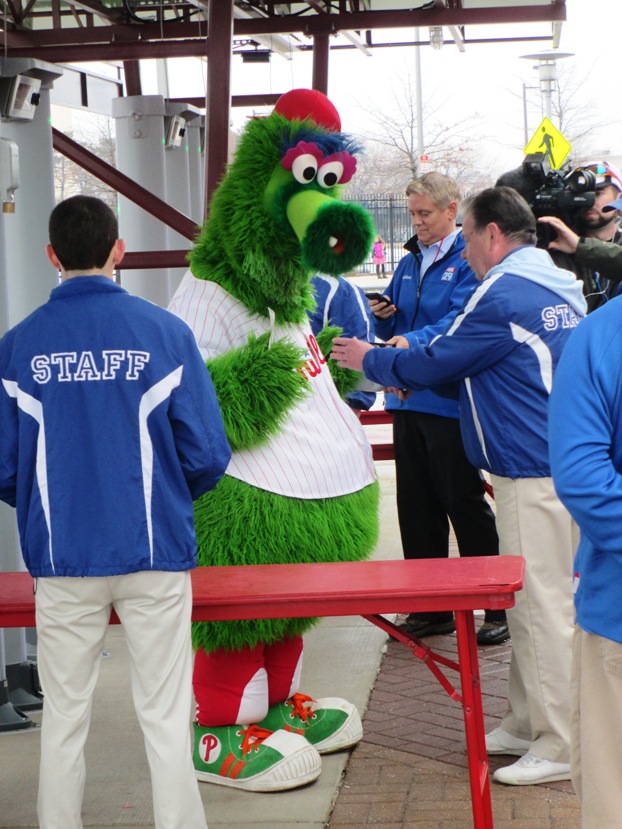
“I’m sorry sir, but your odor is scaring the kids.”
“This Costume Stinks!”
One service that Raymond Entertainment Group offers is costume cleaning…a surprisingly neglected aspect of mascot performance for many teams. The cleaning includes a “State of The Fur” analysis. A performer in a smelly costume is not a pleasant one, as Dave notes.
“The Phanatic opportunity for me, it truly was the best job you could ever imagine. But there were things about it that I hated. I hated that costume getting beer spilled on it, for example. I’m very anal retentive, I can’t stand things out of place, and it just drove me crazy. So I was meticulous about how I cleaned that costume.
“The first year, the people in New York that built it said they couldn’t wash it. You couldn’t even imagine what it smelled like. I finally just threw the thing in my bathtub with Woolite. I thought, I don’t care if I ruin it, it can’t smell like this anymore. When I got done cleaning it, it smelled great, and I wrote a note to the people in New York saying hey, this is how you clean it, and they were like, wow!”
Dave actually will frequently take on the cleaning tasks at REG. “This is what small business is about. I’m cleaning a lot of costumes myself. It’s just something that doesn’t require any great skill; you just spend a little time doing it. I have people that help and clean and restore the costumes. But I jump in there and do it a lot. It’s one of those healthy distractions for my mind.”
The “State of The Fur” analysis is for advice on cleaning and storage. “We try to give them feedback on what we all think they’re doing based on what is wrong with the costume. We want to have our eyes on it, because then our costumes last longer. Then people will say hey, when you get a costume from Raymond Entertainment it lasts for ten years.
“We prefer that rather than make money on rebuilding costumes, although we do that. It’s better that they know that their costume lasts three times longer than the competition.”

You too can dance on home team dugouts!
Mascot Boot Camp
Although Raymond Entertainment Group trains performers as part of their character creation package, Dave Raymond also hosts “Mascot Boot Camp”, where performers spend a weekend learning all about the business of being a character in a costume and non-verbal communication. It’s for everyone from new mascots learning the trade to longtime performers looking to rehabilitate their skills.
“It’s a great reality experience. If you want to experience what it’s like to be a mascot, come and experience mascot boot camp,” Dave says. “We’ve never marketed it for that, but it’s a lot of fun and they learn to move and communicate non-verbally, they learn how to take care of their costume, and learn how to take care of themselves physically.
“It’s a deep dive into mascot performance, there’s a real method to it now, where once it was Bill Giles telling me to go have fun.”
There’s another important rule of mascot performance: keep it safe.
“Lighting yourself on fire and jumping off a building and crashing into the ground might be something that people will talk about from now until the end of time, but you’re gonna kill yourself. And you’re gonna ruin the costume.”
REG’s “Angel Investor” – Sir Charles
Every business needs capital to get off the ground, and when Dave Raymond sought an investor for his idea to design and build characters, he found what he calls an “angel investor” who is well familiar with Philadelphia sports…Charles Barkley.
“When he would come to the Phillies games,” Raymond says of Sir Charles, “he would have fun with the Phanatic and we did a couple of routines here and there, where he was smacking the Phanatic around. It was fun. Charles invited me to hang out with him and some of his friends in Birmingham when I was doing minor league baseball in Birmingham one weekend.
“I just called him up, and he said my financial guy likes it, I’ll be happy to do it. His financial guy said listen, people haven’t paid Charles back over the years. I said, well, I’m dedicated to paying him back. I haven’t paid him every cent back, but he keeps telling me don’t worry, it’s no big deal. Charles just wanted to help. In the description of an angel investor, Charles Barkley’s picture should be in whatever dictionary or manual that is talking about angel this or that.
“Nobody knows that sort of thing. Charles has done that hundreds of times, he’s just a generous guy, one of the best people on the planet. I’ll be working until I close the business down to make sure he gets every penny back.”

Franklin has worked hard to get where he is today.
(photo courtesy of phillyfamily on Flickr)
Analyzing “Franklin”
Dave Raymond did some consulting for the 76ers in the rollout of their new mascot, a blue dog named Franklin. The humorous back story of Franklin on the 76ers website shows Franklin’s “ancestors” throughout Philadelphia history, including a missing bite out of Wilt Chamberlain’s “100” sign following Wilt’s 100-point game.
Raymond believes Franklin will be a success, despite the recent “controversy” surrounding the character—that Darnell Smith, who wears the Franklin costume, was a Knicks fan.
“One of the things he said to me was, I really need to be a Philadelphia fan, you gotta help me with who the Philadelphia fans are. He worked for MSG, and he was a mascot for the Liberty, the WNBA team. He’s done a lot of work with their performance team, the dunk team, all of that for the Knicks.
“Darnell is an awesome human being and an unbelievably gifted performer. I went to the first game that he was at just a couple of weeks ago and brought my kids, and he was kind enough to come up and interact with us. All the fans in our section were screaming for him. It was for kids by kids, which is what Tim McDermott said he wanted to do.
“What’s nice about it is that he recognized that getting in touch with the psyche of the Philadelphia fan was important. That just shows what a good performer he is. He’s an asset to the 76ers organization, I’m glad they got him.”

Being Relentless – The HEADstrong Foundation

The story of the founding of the HEADstrong Foundation is both heartbreaking and inspiring. I interviewed Cheryl Colleluori, the president of the Foundation, for Winter 2019 issue of JerseyMan. She is a remarkable, exceptional human being…a true warrior and survivor. You can read the article on JerseyMan’s website or you can view the PDF of the article here.

Nick Colleluori, the founder of the HEADstrong Foundation. (photo courtesy of Cheryl Colleluori)
Being Relentless
The HEADstrong Foundation is the brainchild of Nick Colleluori, who lost his life to cancer at the age of 21. Like Nick, the Foundation is relentless in helping patients and families affected by the disease.
Nick Colleluori sketched out the HEADstrong Foundation logo on his way to an operating room, in the midst of his battle with non-Hodgkin’s lymphoma.
His mother, Cheryl, remembers it well.
“He asked me for a piece of paper and pencil. I didn’t have a paper and pencil, but I gave him a napkin and he just started doodling. I wasn’t even paying attention. My husband and I were sitting there talking, trying to remain calm, giving him that assurance that this was going to be okay.
“They’re wheeling him in, and he turns the napkin around and said, ‘here’s the logo.’ I said, what are you talking about? He said ‘the logo for the Foundation. I’m starting it.’
“I thought to myself, man, this kid is relentless!”
When the 19-year-old three sport athlete was diagnosed with the disease that ultimately would take his life, he wouldn’t spend a minute letting anyone feel sorry for him.
“He made it really easy for us,” says Cheryl, who is now president of the Foundation. “He made the whole journey just very bearable, if you can imagine that. He was so upbeat, and you would never ever see a frown on his face. I felt very privileged that I was his mom.”
Nick spent his 14-month fight…which was 11 months longer than doctors initially anticipated…noticing every resource that was lacking for cancer patients and their families. Challenges like financial help, a place to stay during treatments, and the need for understanding and support. As his mother says, at a time when he could have been selfish, he chose to help others instead.
Today the HEADstrong Foundation he founded is doing just that, in a huge way.
They connect patients with survivors to speak with and mentor them through the ordeal. They host events and provide entertainment for patients throughout the year, including an annual Thanksgiving feast at the Hospital of the University of Pennsylvania. And patients coming to Philadelphia for treatment can stay in Nick’s House, in either of two locations in the Philly suburbs.

Nick’s House in Swarthmore, PA, a beautiful place to be, especially in the fall.
The idea for Nick’s House was born out of the Colleluoris visiting NIH in Bethesda, Maryland, for a clinical trial.
“We were in an 8×10 room and there were seven of us,” Cheryl remembers. “We were on sleeping bags. We were so grateful, but it was not conducive for a long term living arrangement. We met a family living out of their car, which is not unusual. We thought, let’s do something.
“Our first Nick’s House was born seven years ago, and we refinanced our house to purchase this house. It took my husband six, seven months to renovate. The second home in Swarthmore opened in February after one year of renovation.
“We’re not just children, we’re all ages. Pediatric, geriatric. We are all cancers. And the common theme is that they’re traveling a distance of 50 miles or more, and they’re coming here for an extended period of time. Nick’s House becomes their home. They can read a book, be part of the neighborhood, go for a walk, you know, they’re in a safe and secure environment.
“I just love it. I’m so proud of it. The greatest gift for me is seeing complete strangers become one family.”
That the Colleluori family has been there is their greatest asset in helping other families.
“When people come to Philadelphia for treatment, they’re leaving behind everything they know. We become their family and their support system. We are very family rooted, hands on, in the trenches with the families. We are that family. We were that family. We understand everything that they’re going through.
“I get this a lot: When will I know, when should we make the decision, if things aren’t going well? And my response is, you’re going to know. I also say, don’t go there until you have to.
“A lot of times the minute you hear the diagnosis, oh my God, my child’s going to die. Well, guess what, we have seen hundreds of children that are still here with us, that have made it, that have survived. My message to other parents is keep positive no matter how bad it gets, and don’t go there.
“That little bit of information was shared with me, because I went down that path too. You hear the word cancer and you’re just in such a tailspin. You don’t even know what to do next.
“One of the greatest compliments I’ve ever received was from a mother of a terminally ill child. She held my hand and looked into my eyes and says, you are my role model. Those are the only five words that I ever need to hear, to know that she can see me standing still. I’m still standing.”
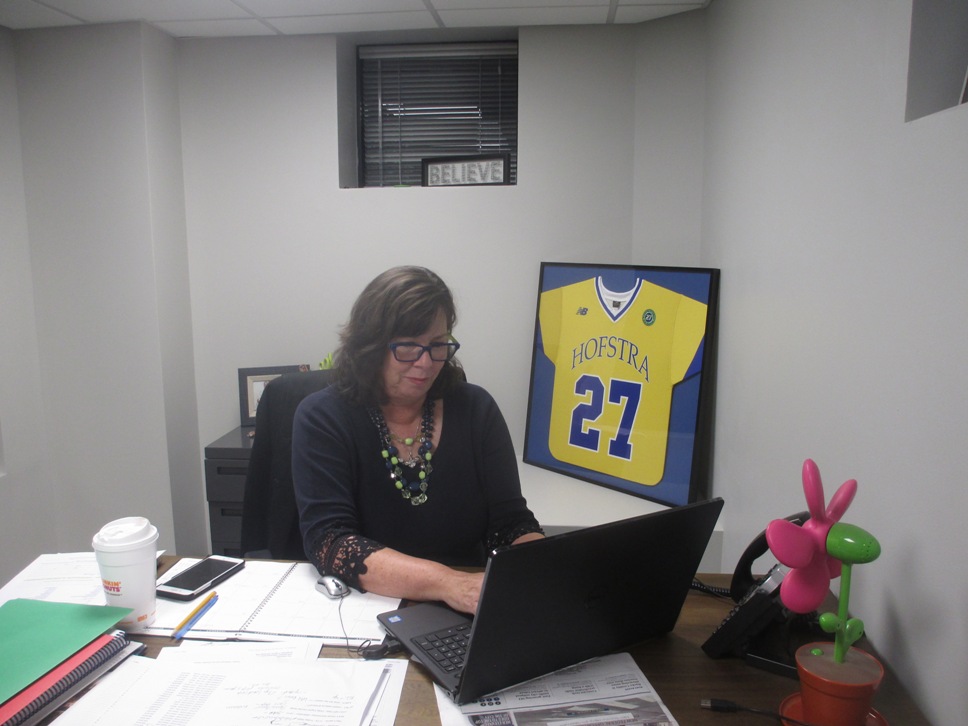
Cheryl Colleluori, with her son’s uniform providing the inspiration.
Cheryl Colleluori is never afraid to be human. She has no problem choking up and occasionally pausing to gather herself, even while speaking with a writer she’s never met over the phone. But in mere seconds she is back in the game, speaking of the goals of the Foundation. “Be relentless” is its motto.
JerseyMan has profiled dozens of successful entrepreneurs. They almost always speak of the importance of getting back up again. That there is no substitute for perseverance.
If you want to see an example of someone who relentlessly gets back up, it’s Cheryl Colleluori. She is still going strong every day, meeting with patients, consoling them, supporting them every way she can. Like her son, she’s as great a teammate as you could ask for.
There are, of course, moments. The blow life dealt her was enough for her to faint dead away in her first visit to a hospital, to distribute “Comfort Kits” to cancer patients.
“I stepped out of the elevator and passed out,” she remembers. “Because all of a sudden what hits you is the smells, the sounds. You know when you’re walking into the room. I was thinking, I don’t know if I can do this.”
But she did. Because her son’s relentlessness still gives comfort and hope to thousands. Cancer may have taken his life, but even now, he won’t let it beat him.
After Nick’s passing, the family was so heartbroken that they sought a medium to possibly bring them some comfort. Cheryl says that to their surprise, the medium knew things that no one could have known, including details about Nick and his girlfriend of eight years, Jordan, exchanging wedding vows the night before he passed.
“The medium said to me, ‘your son is telling me that you are his mouthpiece.’ When I got the phone call two days later to speak, my husband said you can do this for our baby. That was the start, and the rest is history.
“He is guiding us. There’s no doubt in my mind that he is still providing the direction and my inspiration.”
When the doctors could do no more for Nick and sent him home, he took the car keys from his devastated father and let his mother drive. On the way home, he spoke with her about his final wishes, including for Cheryl to take HEADstrong as far as it could go.
“He said, Mom, look into my eyes and tell me that you can do this for me. His exact words to me were, ‘I want other people to benefit from my life.’
“How do you say no to that?”

Helping The Foundation Stay HEADstrong
The HEADstrong Foundation has been an enormous success since the passing of its founder Nick Colleluori in 2006. They have raised over $14.4 million and have assisted over 15,500 families affected by cancer. In addition to two Nick’s House locations that can simultaneously host eight families, they served Thanksgiving meals to five floors of patients in 2018, have hosted dozens of fundraising events and have delivered hundreds of their “Comfort Kits”.
But as Cheryl Colleluori will tell you, it’s not without challenges. Nick’s House requests are frequently coming in, as more families travel from hundreds of miles away for specialized treatment that is only available here. She notes that there are 280 families a month in need of housing just in Philadelphia.
Families at Nick’s House are charged nothing for their stays, which can often be 50 days or more. This is in addition to their financial grants for families struggling with costs, dinners and events, and the multiple other services HEADstrong provides to families.
“We want to have the greatest impact we can in Nick’s name,” Cheryl says. “We want to help as many people as we can, and make sure we have the right people in place that bleed like we bleed, that breathe like we breathe. We have a lot of people that we’ve helped that have lost their loved one and they now have an opportunity to set up fund in that loved one’s name, and paying it forward for the next family. And that’s been a nice opportunity of growth for us.”
Nick’s House and the HEADstrong Foundation subsists entirely through volunteers, partnerships and donations. If you’d like to contribute or volunteer, you can find out how at https://headstrong.org.

Cheryl in Nick’s House, bringing hope to those who most need it.
The Comfort Kit
One of Nick’s innovative ideas for helping cancer patients was borne out of the experience of being on call for hospital visits. It’s called the “Comfort Kit”, and the HEADstrong Foundation regularly delivers them to cancer patients.
“A lot of times when someone’s admitted to the hospital,” Cheryl says, “you need to report right now because there’s a room available. Or, you’re in the emergency room and you’re admitted on the spot. You don’t have anything with you from home.”
The Comfort Kit includes a set of items that people without experience in this realm probably wouldn’t think of, as she explains:
A journal and a pen – “2:00 in the morning you wake up and ‘oh my gosh, is this normal? I have a question for the doctor. Am I going to remember?’ There’s your journal, jot the question, write it down.”
A blanket – “It provides warmth and comfort and it personalizes the room.”
Tissues with aloe – “Tissues in the hospital are so paper thin.”
A toothbrush and toothpaste – “A soft bristle toothbrush, because toothbrushes in hospitals fall apart when you use them.”
A gift card – “I don’t have any money and I need to get out of the parking lot. Or, I could really go for coffee, let me run down to the cafeteria. Oh darn it, I don’t have any money. Well, don’t worry about it, because there’s your gift card.”
Information about HEADstrong’s Peer Support – “You just never know when somebody’s losing it on the floor and they want to talk to somebody.”
Comfort Kits are hugely appreciated by patients, Cheryl notes. “It’s just a great way to enter somebody’s room and say, hi, how are ya? I’m Cheryl Colleluori with the HEADstrong Foundation. I’m thinking of you today and I hope this makes you smile. I hope that you know that there’s somebody here fighting for you that you don’t even know. A lot of times people are like, I was hoping you were going to come, I heard about this!
“I get great reward out of bringing a smile to someone’s face and my team. We go down with about 15 volunteers, and every one of those volunteers are survivors that I met as I handed out their comfort kit.”
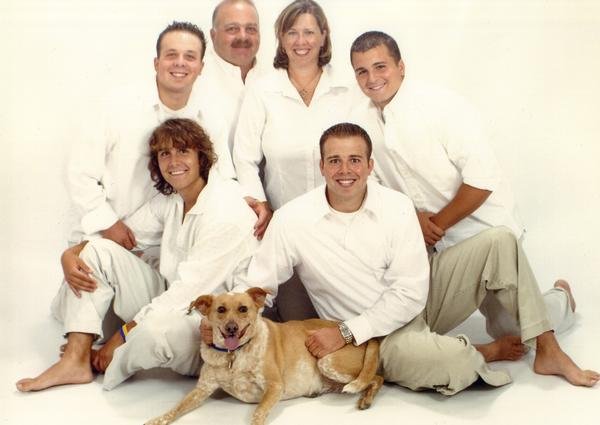
The Colleluori family, the best teammates you could ask for. (photo courtesy of Cheryl Colleluori)
The Mental Game
The HEADstrong Foundation’s Peer Support program connects survivors and family members to share their deepest and most private concerns. Generally they will find a survivor of the same age group and background to speak with a patient or family member.
“My sons are very involved,” Cheryl says. “They talk to siblings, my husband talks to dads, I talk to moms and dads, and the peer support is not over when someone passes. If the person’s gone a couple of years, it doesn’t mean the relationship with the HEADstrong Foundation is over. We’re still very highly involved with families.”
HEADstrong is relentless in helping people stay as upbeat as possible. But Cheryl absolutely understands that it’s almost impossible for patients not to get down sometimes. “There’s a lot of sadness. We cry right with people.
“We try to talk about other things. We try to get people’s minds off of the fact that their health is declining. If somebody wants to talk about it, I will, we understand. Nick was tired, we know. But if we get somebody’s mind off of it, they forget. A lot of it is a mental game.
“In two weeks, we’re going to the Sixers game, and we’re taking 26 people with cancer with us. We do the programs in the hospital, we have people in wheelchairs and oxygen, and IV poles. They’re getting blood and getting chemo and we bring them into the room and have a magic show, or we play bingo. Or we have jazz night and they’re singing and clapping. If it’s for an hour, we’ve just improved their mental state.
“We’ll do art therapy. One guy, I’ll never forget, he was so weak. We took him back to his room and the next thing we know, he’s back. The nurse has got him back at the door and I said, are you okay? He’s like, ‘I have to finish this for my daughter.’
“He finished the painting, and I took him back and he said, ‘can you place it right there for me? I’m going to take a picture, I’m going to send it to her.’ He said, ‘you’ve given me the motivation I needed to get the heck out of here and get home to my daughter.’ We still keep in touch with him today.
“It’s just those little things to help people get through the darkest days.”

Surviving Until Tuesday – Sergeant Andrew Einstein

Andrew Einstein is one of our nation’s true heroes, yet he was driven to the brink of suicide resulting from a head injury and lost sense of meaning. JerseyMan sent me to interview him as he told me what real strength was to him. You can read the article on JerseyMan’s website here, or view the PDF of the article here.
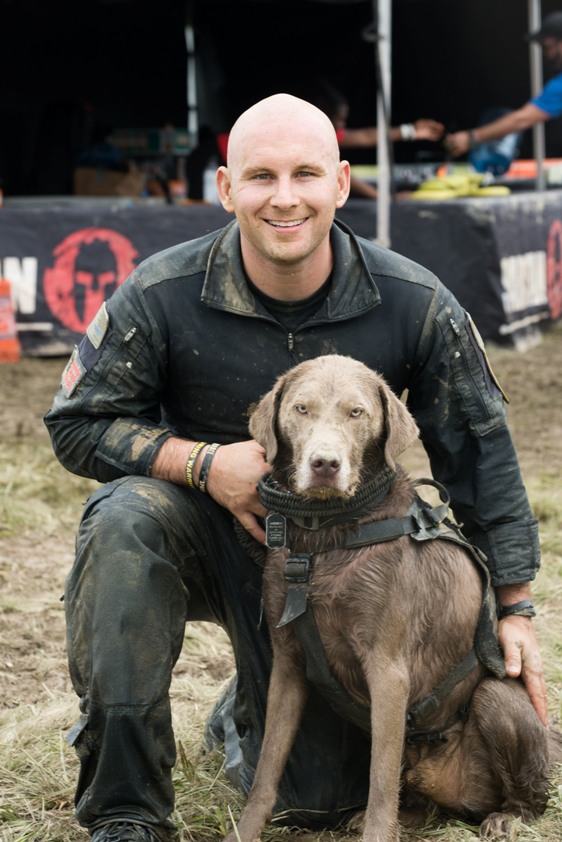
Sergeant Andrew Einstein with Gunner, the Silver Labrador who was there to save his life. (photo courtesy of Andrew Einstein)
Surviving Until Tuesday
Camden County Police Officer and U.S. Marine Sergeant Andrew Einstein speaks openly about being on the brink of suicide, pulling himself out, and living a life with purpose again.
On August 5, 2011, in the Sangin Valley region of Afghanistan, Sergeant Andrew Einstein of the U.S. Marine Corps sustained a brain injury from a grenade attack.
He didn’t think it was a big deal at the time.
“Kids would throw rocks at patrols and stuff to mess with us,” Einstein says. “I remember looking down and going, it’s just a rock. I saw there was an Afghan soldier, and his eyes were just like…I looked back down and said, oh, that’s not a rock. As I went and turned to get away from it, I got a couple of steps and it went off.
“I remember grabbing my ear, my ear hurt so much. I yelled, I fell into one of the rooms. I crawled out and that same Afghan soldier, he was wearing a white shirt, he fell to where I was and his white shirt was red.
“I remember being really confused. I said, why is his white shirt red? He obviously had received some shrapnel, and I put a tourniquet on one arm and then I went to put a tourniquet on another arm. They took care of him, and I sat back and lit a cigarette.”
He wasn’t bleeding, he didn’t lose any limbs, and he had no bullet holes. Just migraines. To Einstein, it wasn’t a “real” war wound…especially happening on the same day that fellow Marine Daniel Gurr was killed.
He was, he knew, ready to get back to the fight.
A country that values freedom never has enough people like Andrew Einstein wearing military uniforms. But as it turned out, the injury was a big deal. Less than a year later, it was a contributing factor in his decision to end his life.
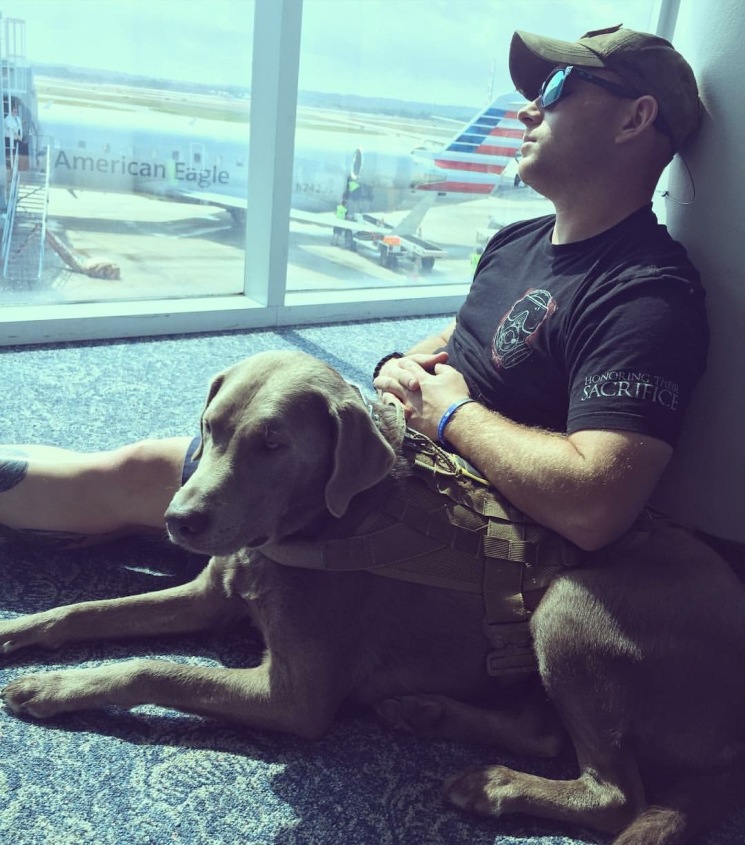
Einstein with Gunner, keeping him in the fight. (photo courtesy of Andrew Einstein)
That, and a lost sense of meaning back home.
“Coming home feels great,” Einstein says. “Then you realize that life went on, and you’ve got to figure out how to get back into your old life. And then comes a time, at least for me, where I said, I want to go back. I need that responsibility and that purpose that I had over there.
“I know the head injury really caused a lot of issues. The biggest issue was the hearing loss and then the memory issue. I was afraid that if I got help, they would take my badge and gun and say, sorry, you can’t be a cop anymore. I’ve been a cop since I was 18. That’s all I know. And I love being a cop. Aside from being a Marine, this is my life.”
As Einstein increasingly saw it, it was a no-win. Fight your losing battles alone or give up the responsibility. As time went on, the stress of what he perceived to be a meaningless life continued to mount.
By May of 2012, he couldn’t take it anymore.
“I wrote letters to my family. I’ll never forget what I wrote to my youngest sister. I apologized. Because up until that point, she looked at me as this hero. I was her brother, a police officer, a Marine who went over and fought for our country. I said, I’m sorry for lying and making you think I was so much stronger than I actually was, and I’m not a hero. I’ll never forget writing that because those words were the hardest.
“I put the bottle of pills next to my bed. I went out and drank so much that my friends plopped me on the couch. No one knew that 15 feet into the bedroom there was a bottle of pills that I’m planning to kill myself with. I remember waking up the next day, and I was disgusted. I couldn’t even kill myself.”
The date Einstein picked to be his last was fortuitous. He wanted the new dog he had agreed to pick up the following morning to have a loving home, and not be his family’s responsibility. After failing his suicide attempt, he went to pick up the dog.

Officer Andrew Einstein at the office.
It turned out that Gunner, his new Silver Labrador, didn’t need a loving home. He needed a purpose too.
“As soon as I picked the dog up, I said, ‘I can’t kill myself, because I’ve got to be there for this dog now.’ All of a sudden I had responsibility again. Even when I was still doing the things I was doing, he was there for me. He didn’t judge, he didn’t care; he loved me. He would lay right on me.”
Einstein gives Gunner credit for saving his life. But he soon caught another break when his chief at the Riverton Police Department, John Shaw, could see he wasn’t well.
“He said, I don’t want you to lose your job, and I want to help you. I said, well, if he’s reaching his neck out for me, who am I not to try and get better.
“I went to doctors, I started going to groups and talking about the issues. My dog and I went into training, so he could become a service dog for me. It was definitely two steps forward, one step back, but each step, it got brighter and brighter. It took time, but we just started getting better and life became better.
“You always say, if you could talk to your 18-year old self. If I could talk to my 2012 self, I’d say, ‘Get off the couch and go get help. You can do this.’
“I’m telling you this is strength…raising your hand and saying, ‘I am not okay. I need help.’ One of my biggest things that I speak to now is with the first responder community, when there’s bosses or administrators to understand how or what to do if they have one of their personnel go: ‘I’m not okay.’
“However bad it is in your life,” he adds, “I can’t tell you when it’s going to get better. Hopefully it’s the next day. In reality, it’s not going to be the next day, or the day after that. But if you fight to get better, I promise you at some point, it will get better.
“I tell people, if you’re going through something, not just suicidal, you’re going through a gray dark time. If there’s something in your life that you enjoy doing, whatever it is. If once a month, every second Tuesday you’re going to play basketball with your friends, and you know that in that hour you’re totally relaxed and everything is great?
“Live to that Tuesday. Because you know each second Tuesday of the month, you’re going to have that hour of peace. No matter how bad your life gets in between, live for that Tuesday. And then live again for the next Tuesday.
“If you only have that, live for that Tuesday.”
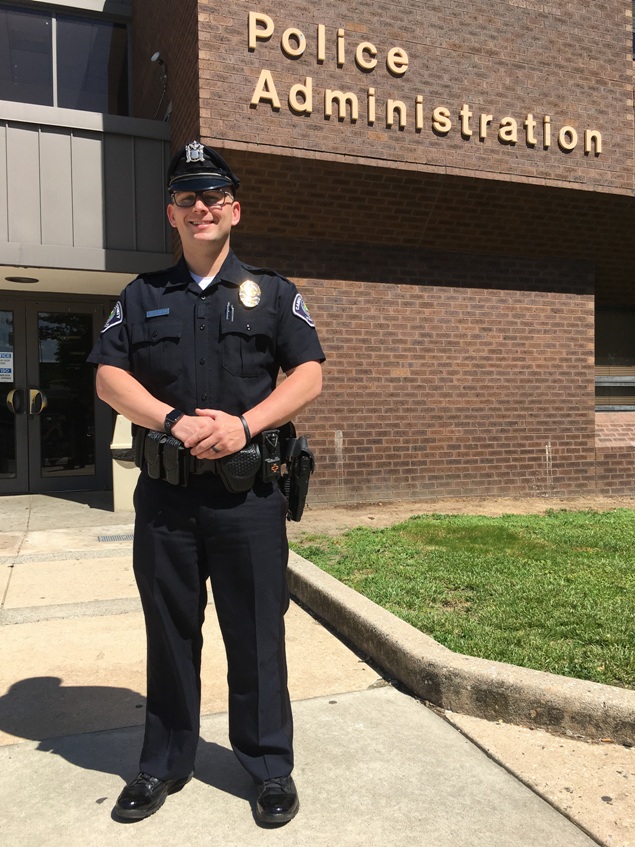
Serving the community, with his own experience.
Andrew Einstein is no longer surviving until Tuesday. He is now an officer in the Camden County Police Department, where he uses war and post-war experience to break trust barriers with city residents.
“One of the first things they said was: we know about your story and we want you to tell it, because we want you to help others.
“In this city, we have people in crisis every day, and these people have lived hard lives. I have to break the barrier, the same barriers I had to break in Afghanistan, to show them, look, I know I can’t relate to your life. But let me in, open the door a little bit, let me show you that I’m here to help.
“We try to de-escalate the situation as quickly as possible, and when someone’s in that moment, I can say, hey, hold on. I’ve been there. Guess what, May 5th, 2012, I was where you were.”
“I love getting the bad guy off the street. But I also love talking to the person in crisis or the person who just wants to talk. Dealing with the people here, it’s not all about busting the bad guys. Sometimes it is about throwing the football with the kid on the block or playing basketball. It’s showing the people that you serve, that you’re a person.
“I don’t say being suicidal helps you become a better person in the long run. It’s you take what life dishes at you and you learn from it.
“What I’ve dealt with in life, I’ve been able to use to mold into a better life.”
Today, the city of Camden has Officer Einstein and Gunner to thank too.

The World’s 7th Most Interesting Man – John O’Hurley

You may remember him best as the off-the-reservation J. Peterman, Elaine’s boss on Seinfeld, or as the host of Family Feud for several years. But John O’Hurley has done a lot of other cool stuff too.
I was fortunate enough to interview him for the June 2016 issue of JerseyMan, and he couldn’t have been cooler, giving little ol’ me almost an hour and a half of his valuable time and even sharing a Firesign Theater reference. You can view the PDF of the article here.
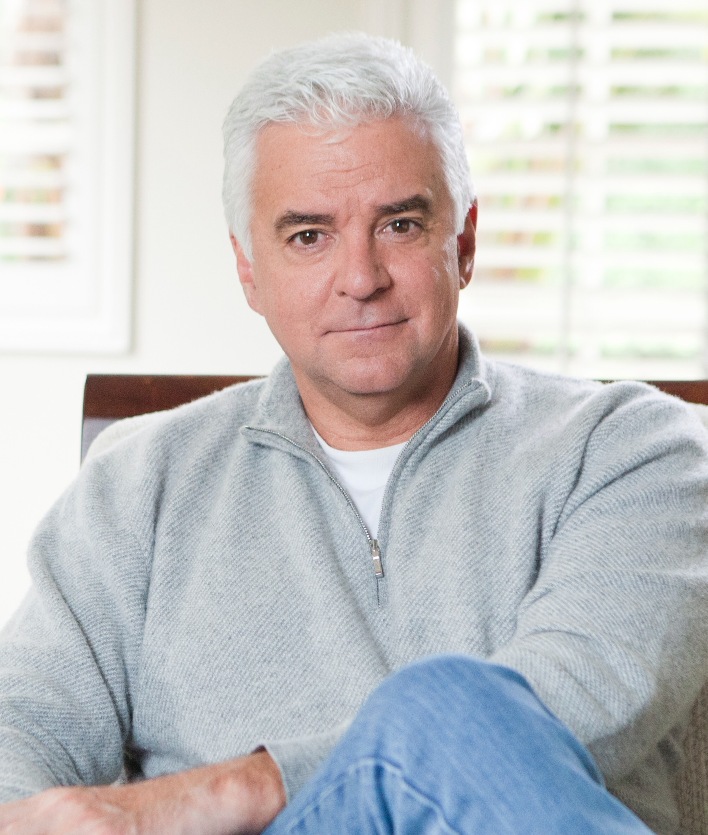
John O’Hurley, the World’s 7th Most Interesting Man. (photo courtesy of John O’Hurley)
The World’s 7th Most Interesting Man
John O’Hurley doesn’t sit still very often, but when he does, he has an extraordinary life to reflect on.
The first time John O’Hurley read a Seinfeld script, he instantly saw the genius of the Show About Nothing. Even if he didn’t consider it genius at the time.
O’Hurley had to be nudged to play off-the-reservation catalogue owner J. Peterman…a role that, given his own eccentric demeanor and storytelling ability, he seemed born to play. When he gave in and read the script, he couldn’t believe that Seinfeld was the number one show on TV. Because the show didn’t read funny.
Imagine reading a classic Seinfeld dialogue and it becomes obvious what O’Hurley means.
“It was the un-funniest show to read,” the portrayer of the now iconic character remembers. “There’s no setup. If I showed you, say, a Golden Girls script, you can see, setup setup setup, punchline, setup setup setup, punchline. Generations of script writers lived off of that form.
“Then Seinfeld came in, it grew out of standup comedy, observational humor. It was basically the notion of being in an elevator, that is New York, the sense of small spaces and rudeness and everything is always on edge, relationships or whatever. It was all about conversation, because everybody talks in New York. That’s why Peterman existed, because he was not only about language, he was about the long form. The writers got to write monologues every week, rather than writing one or two lines for each character.”
If you’ve ever looked at a J. Peterman catalogue (yes, J. Peterman is a real person), you can see why it appealed to sitcom writers whose strength was dialogue. A typical entry reads like this one, for the “Grace Under Pressure” cotton T-shirt: “MI6 operatives sat at noirish watering holes with Gestapo and Portuguese secret police, all waiting for the other to reveal the whereabouts of the Nazis’ cache of gold or an allied shipping lane. Wealthy refugees negotiated the sale of their art collections. Prostitutes doubled as informants. You’ve heard of Casino Royale? That’s this place.”
That’s the real J. Peterman. It was as if the character’s lines wrote themselves.
“They wanted him to sound the way the catalogue was written,” O’Hurley recalls. “They didn’t even have the full script written, because it was the most disorganized show on television. So all they had was the catalogue and a couple of lines. I’m going through this and thinking, OK, this is 40s radio drama and bad Charles Kuralt. So it had this sort of Centurion poet standing on a cliff type of feel about everything. Even a walk to the men’s room was an adventure. (imitating Peterman voice) ‘I have no idea what I’m going to find serving a basic desire!’”
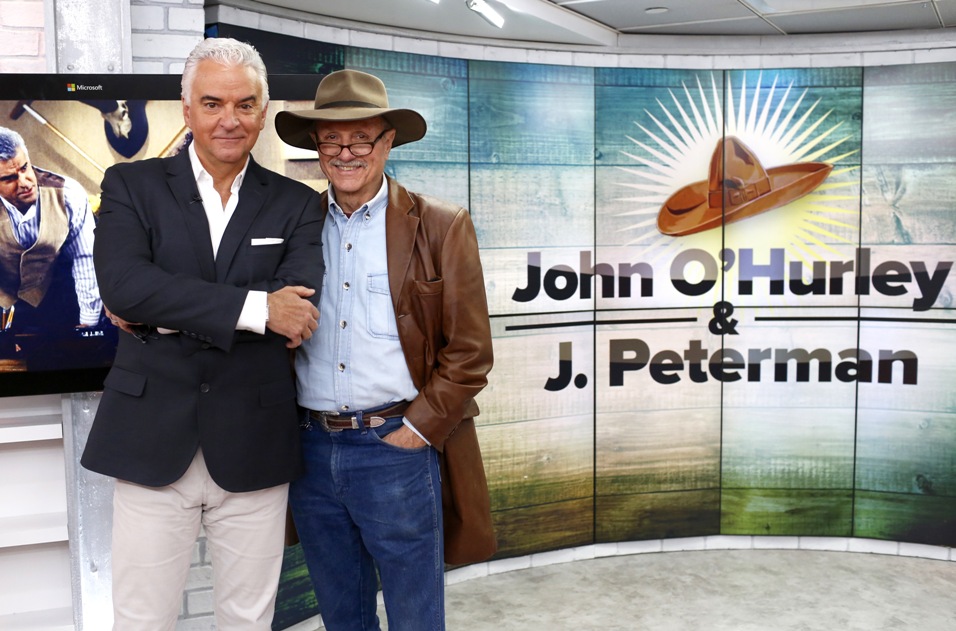
Seinfeld’s J. Peterman, with the actual J. Peterman. (photo courtesy of John O’Hurley)
The J. Peterman catalogue not only still exists, it’s part owned by O’Hurley now. The two men have walked on Madison Avenue together and heard New Yorkers shout “Peterman!” at O’Hurley, ignoring the in-the-flesh Peterman.
One of the catalogue’s newest offerings is the Urban Sombrero, in an ongoing and humorous Kickstarter campaign that has raised $96,000 as of this writing.
In case you haven’t seen that episode, the Urban Sombrero is an invention Elaine conjures up when the chronically unstable Peterman breaks down and runs off to Burma, leaving the company operations in Elaine’s hands.
The Urban Sombrero…a hat that combines “the spirit of Old Mexico with a little big-city panache”…turns out to be a colossal flop, to the point where Elaine overhears men on the subway talk about how the Urban Sombrero ruined their lives. In the show, Peterman himself reacts to the idea with similar distress, muttering “the horror…the horror”.
Indeed, if you were working for a clothing firm and heard someone suggest the idea of an Urban Sombrero, you might imagine you were in a Seinfeld episode. It took 20 years of cajoling from the fictional Peterman to persuade the actual Peterman to make this essential skypiece available.
What caused the eventual change of heart?
“I think he finally realized that at some point he was going to have to embrace the Seinfeld audience of 80+ million and try to draw them across the aisle into the Peterman world. There was a little bit of unconscious reluctance to accept them. When you think about it, I’ve basically stolen his identity; I’ve become his company. All of a sudden this poor man has nothing left, he’s lost his identity. He never understood, I don’t think, the Seinfeld phenomenon.”
Pop culture reverence aside, for us Philly area folks, O’Hurley points out the advantages of the Urban Sombrero as an ideal Jersey Shore accessory.
“It’s the absolute answer to the SPF problem. When you can’t decide between 15, 30, 60 or 70 and you go, oh my God, what do I choose? The Urban Sombrero. And not only that, it says, I think I’m gonna take a nap. Why not do it with a little bit of a panache?”

O’Hurley with several best friends. (photo courtesy of John O’Hurley)
O’Hurley spends time in the Philadelphia area each year, hosting the National Dog Show in Oaks that has become almost as much of a Thanksgiving Day tradition as the Macy’s parade. The National Dog Show was created way back in 1879 by the Kennel Club of Philadelphia; O’Hurley has been hosting it since 2002.
Like the Peterman character, it seemed an obvious choice to make O’Hurley the emcee of the show. Coupled with his game show host experience, he has an exceptionally thoughtful appreciation for canines. He’s authored three books about dogs and their impact on our lives; “It’s Okay To Miss The Bed On The First Jump” is a New York Times bestseller, and “The Perfect Dog”, a children’s poem, has been adapted into a children’s musical that is now part of National Dog Show Week.
“If you have a dog in the room,” O’Hurley relates, “everyone comes and pets the dog. If there’s a dog in an elevator, everyone is looking at the dog. Whatever the natural behavior of the dog is, everyone is going, awww. They calm us down; they round the edges in our lives. They take the brittleness out of things. That’s what dogs do.
“If you’re around 2,000 of them, and they don’t care if they win, everybody else seems to be happy so they’re happy. And they’re appreciated, and they know it, and there’s a sense of energy that they know that something important is going on. All of those things lead to just a great environment for everybody.
“It is the happiest day of the year. It’s as simple as that.”
The well-traveled host not only says nothing but nice things about visiting Philadelphia, he can do so without even dropping the name of an iconic sandwich shop.
“My favorite thing about Philly is the authenticity of the history there. The actual documents, walking around and actually being in arm’s reach from some of the most important legislation that was ever done in this country, the Constitution and the Declaration of Independence.
“I did the musical ‘1776’ many times, and I think that every time I pass that building, that they all stood in and sat in, and how sweaty that must have been and how miserable they must have been, and yet to put their names on any one of those documents was basically signing a lynching mob. I think of that every time I pass that building…my goodness, the courage they had to do what they did.
“On top of that, I love walking up and down the streets, and seeing the preservation of the areas. I love staying in some of the little boutique hotels. We love Oaks too, mostly because my wife refers to Nieman Marcus as the mothership out there in the King of Prussia Mall, which is the best place in the world to shop.”

No, this wasn’t his dance partner on Dancing With The Stars. (photo courtesy of John O’Hurley)
You don’t have to be a Seinfeld fan or a National Dog Show viewer to have seen John O’Hurley’s visage frequently.
He is a theater star who has played King Arthur in Monty Python’s Spam-A-Lot and currently still plays Billy Flynn in the long running musical Chicago. On stage, he possesses a fine singing voice. Tom Williams of Chicago Critic opined it best: “John O’Hurley brings a big voice and a commanding presence.”
He is a self-taught classical pianist who has released several acclaimed CDs, and is now starring in his own creation called A Man With Standards. “It’s my one-man show of the music of the period when I grew up, a period of time when men had standards. It’s basically piano, and I expanded it all the way up to a full orchestra. It’s fun. I have all these melodies in my head, I’ve got to get rid of them somehow. It’s a dangerous place up there.”
He has ballroom dancing skills too; he made it to the finals of the first season of Dancing With The Stars, and winning a dance-off following a hotly disputed (to say the least) loss in the original final.
And he was probably the most elegant host of Family Feud in the history of the show.
“I’d worked with them on a show previous, called To Tell The Truth. You remember, will the real so-and-so please stand up. They were looking for a new host for Family Feud and I said yes. It’s a different style of hosting; with To Tell The Truth I sat down, I had a nice little thing to read with a story, panelists, that type of stuff. With Family Feud, there’s no script, you are literally out there hoping the net will appear.
“That was when I began what I call the prayer. I say God, let me be surprised. That’s all I say, and that’s what I say before I go on stage. It relaxes me to say that I’m not in control of this thing, so I can go out and relax. It was like hosting a cocktail party, we really cared about the fact that all these people came to your party.”
Last but not at all least, he’s the father of the first ever third-grader Vice President of his school. According to O’Hurley, at the age of nine, his son had already mastered the art of persuading people to eschew politics as usual…which at the school meant voting for a sixth-grader…and won in a landslide.

John O’Hurley, author of The Peterman Guide to Living an Extraordinary Life. (photo courtesy of John O’Hurley)
On his Twitter account, John O’Hurley proclaims himself to be the World’s 7th Most Interesting Man. When asked who #1-6 are, his answer is no one specific. Just that there’s probably only six people in the world having a better day than he is.
It’s a humorous worldview of a good-natured optimist whose attitude has taken him far. But truthfully, it’s a challenge to think of many people who have led more interesting lives. Not many of us have been a recurring character in the most popular sitcom in history, hosted national game shows, emceed a National Dog Show, made it to the finals of Dancing With The Stars, written three books, played leads in traveling hit musicals, and released several CDs of classical piano music.
Someone hosting a success seminar could paraphrase that old cliché: You have the same 24 hours as John O’Hurley. Or they could attend one of O’Hurley’s own motivational speeches; he does that too. He calls his presentation The Peterman Guide to Living an Extraordinary Life.
“I wake up every day with this goal: I have to find a way to stay relevant every single day of my life. And what I live by is this premise, and this is what I speak about: you have two choices in life. You can have an ordinary life, or you can have an extraordinary life, and it has nothing to do with power or money; it has everything to do with the power of your choices.
“God speaks through imagination. He puts pictures in your mind of what you’re supposed to be doing. Your rational mind knows everything you’re afraid of, and it has an agenda, but your imagination? No agenda. It only knows the best of what you are capable of, and it always pushes you forward to the next thing you’re supposed to be doing.
“I’ll talk to hedge fund guys on Wall Street, two thousand people in the room, and every one of them is taking notes, and I love that. And I say, if you do not believe that what you imagine has value, what I would ask you to do right now is put your pencils down, get up out of your chair, drop to the floor, curl yourself in a little fetal ball, and wait there for the sweet embrace of death. Because you will not improve your life one iota unless you value what you imagine, not what you know.
“And everyone picks up their pencils and starts writing again.”
“I’m very, very lucky, I’ve been in the right place at the right time, but all of those things I did, I did because my imagination said, I’m supposed to do this.”
With all respect to Jonathan Goldsmith, it’s a shame that O’Hurley didn’t star in the ‘Most Interesting Man In The World’ spots. The Dos Equis people would have had a lot to work with.
“He was once asked to star on Seinfeld…and proclaimed the script unfunny.”
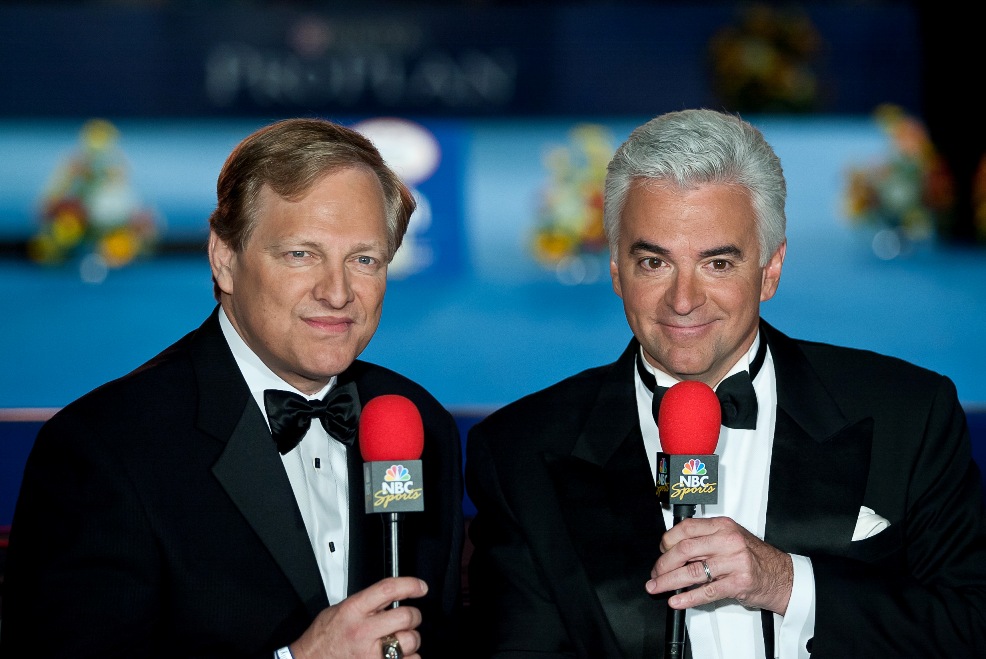
Uh-oh…someone just gave Peterman a microphone! (photo courtesy of John O’Hurley)
The Peterman Monologues
For many years the Seinfeld audience didn’t get to see much of J. Peterman at his maniacal finest…delivering a lengthy monologue.
“Every show was ten minutes too long,” O’Hurley says. “The first thing to go, we’ll cut the Peterman monologue. These things that I’d spend two and half hours on. I used to orchestrate them musically, because having studied opera I could play with my voice, and I would take it and rise (raises pitch of voice) and then hold, and then fall (drops pitch of voice).
“I would do that because this man was always a piece of walking poetry. Mr. Magoo-style poetry, but poetry nonetheless. He was a walking literary time bomb all the time.”
O’Hurley’s all-time favorite was in an episode where he incorrectly suspects that Elaine might be having a fling with a co-worker, and he encourages them with tickets to a circus. He still remembers the monologue verbatim:
“Don’t worry, Elaine. I too am no stranger to love on the clock. As a young man, my father apprenticed me to a honey factory in Belize. The chief beekeeper was this horrible hag of a woman with nulled teeth and a giant wart that she called a nose. She was not attractive, even by backwoods standards. But love is truly blind, Elaine, and as the days went on, working closer and closer together, that sweet smell of honey in the air; I knew I had to have that horrible creature. And I did. So you and Bob have a good time tonight.”
It may be an exception to the show’s script not reading funny, but that classic, sadly, was also cut from the show. O’Hurley says you can watch some of the monologues on the Seinfeld DVDs.
“They put a good many of them back in, because they’re funny. I actually hosted the presentation of the DVDs. They decided when I talked about that, oh we gotta go back and add that.
“It was just lunatic stuff.”

Dominating the competition, except against ABC alumni. (photo courtesy of John O’Hurley)
The ‘Dancing With The Stars’ Debacle
Most Dancing With The Stars fans remember O’Hurley from the finals of the first season, where he lost to General Hospital star Kelly Monaco in a firestorm controversy that resulted in a dance-off. O’Hurley and his partner, Charlotte Jorgensen, won the rematch easily.
O’Hurley was, in fact, the first ever contestant secured for the hit show.
“I’m the guy that would go to a wedding reception with a glass of wine, and as soon as the music and the dancing started I’d go back and raise a glass and say, ‘Knock yourselves out, Shriners!’ But again, I go back to imagination. I said, I’m 50 years old and I don’t know how to ballroom dance. Shame on me. So I said, all right, I’m gonna do it. I said who else have you got? They said, now that we have you, we can get Evander Holyfield.
“All of a sudden it made so much sense to me. That they were just using this series to give America what they’ve been asking for, for more than two decades: the Evander Holyfield vs. John O’Hurley matchup. Finally! On the level playing field of ballroom dancing! It’s clear as day to me.
“I took him out in the third round with my foxtrot. All it took was my foxtrot and he was gone.”
The finals were a bit more of a mess.
“They boxed themselves into a corner with Kelly Monaco. Because she was on an ABC show, and in 2005 all of that stuff was brand new, active stuff, sign on to the network. Well she’s on a show and she’s got 3 million followers on the website. So she won the online vote every week. There were people that would call, but that was only the hour after the show, and then all week long you could vote online as many times as you wanted to, but you had to have an ABC password to vote.
“You see the dilemma. So when we did the finals and she fell three times during her final dance and I had gotten two 10s and a 9, they had to give her three 10s because she had won the online vote from the previous week. My partner was through the roof. She was so angry about that, that it was never about the dancing. We didn’t have to say anything about it, there were 43,000 complaints the day after. They ended up doing a two-hour dance-off, and I ended up winning.
“I got to rule the roost on that, because I said basically, you screwed up your own series, I don’t give a rat’s a**. I said, ‘I want you to give Kelly’s charity and my charity, the winner’s share, $150,000 or something like that.’”
As O’Hurley often says, you have no idea when you do things the good that’s capable of coming from it.
“We finished it, we won, yadda yadda. We all got the $150,000 for the charity. However, that $150,000 was matched up. CBS did a golf competition, because they were trying to cash in on it. They did a matchup between Annika Sorenstam, the #1 female player in the world, and me. It was a “wolf” competition, more of a gambling game…on certain holes you feel you might be able to beat the person, on other holes not.
“I’m playing the #1 woman in the world, for a pot of $350,000. I won. So that was half a million dollars. My charity was Golfers Against Cancer. I had Michael Milken, with the Prostate Cancer Foundation, match it. It came up close to just shy of a million dollars.
“We started nine projects out of that money. Four of them today are still accepted cancer regimens. And that’s unheard of.
“I always look back on the time with Dancing With The Stars, and I see that four cancer regimens started out of that silliness of everything.”

It’s All About The Bread – Sarcone’s Bakery, Philadelphia
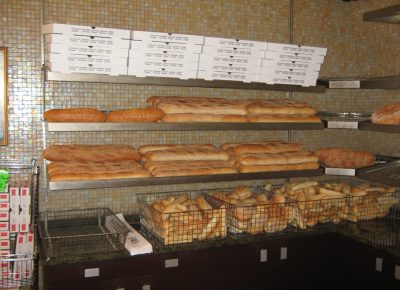
The world’s best bread? Maybe. JerseyMan sent me to write a piece about Sarcone’s, the fifth-generation Philadelphia bakery. A lot of fun to write, and an iconic place to visit and pick up some truly amazing bread. You can view the PDF of the magazine article here.

Bread worth waiting in line for.
It’s All About The Bread
Sarcone’s Bakery is in its fifth generation of baking bread for Philadelphians.
If you’re wondering just how good the bread is from Sarcone’s Bakery, consider that the winner of the Travel Channel’s “Best Sandwich in America” changed their rolls to Sarcone’s…after taking the prize.
In 2012 Adam Richman’s popular show spent ten episodes—with several elimination rounds—deciding which offering of meat on bread was the best in the nation. DiNic’s Roast Pork in the Reading Terminal Market won the hotly contested honor.
“The day after he got that trophy,” says Louis Sarcone Jr., the fourth generation owner of the venerable bakery, “the first thing he did was switch his bread to Sarcone’s.”
A bold move, to say the least.
“People were blown away by it,” Sarcone remembers. “You just won best sandwich in America. Not Philly, America! His answer was, we want to stay the best. How do you improve our sandwich? We improved our bread.”
To those familiar with Sarcone’s Bakery on South 9th Street, though, DiNic’s switch isn’t as earthshaking as it appears. The irony is that in changing a national award-winning formula, DiNic’s turned to an institution that hasn’t changed anything in 96 years.
At least they went with someone who has the technique down.

Three generations of bread-making Sarcones.
Sarcone’s has survived two World Wars, the Great Depression and every recession since. But perhaps more remarkably, it has survived what can be the toughest challenge several times…the next generation.
Sitting relaxed on the store’s window ledge, Lou Jr. shares the secrets of the family’s continued success. His son, Louis Sarcone III, stands patiently nearby, occasionally offering his own thoughts but seemingly more to learn the art of the interview from Dad…who is clearly versed in giving them.
“If you don’t listen to the generation before you, something gets lost,” Lou Jr. says. “You have to pay attention, and that’s the hardest thing for generational businesses, listening to the one before you. Even if you disagree with that person, you can really screw up a family business if you don’t listen.
“My grandfather, the first thing he told me was, if you put too much food in your mouth, you can’t chew. The younger generation sees a business, they see financial, they see money, they see an opportunity for the brand. If you try to expand too much, you lose something. You lose control of a business, you may lose a recipe, you may lose the quality of the product.
“But if you keep your product the same and keep trucking along, your customers will always come in because you make a great product.”
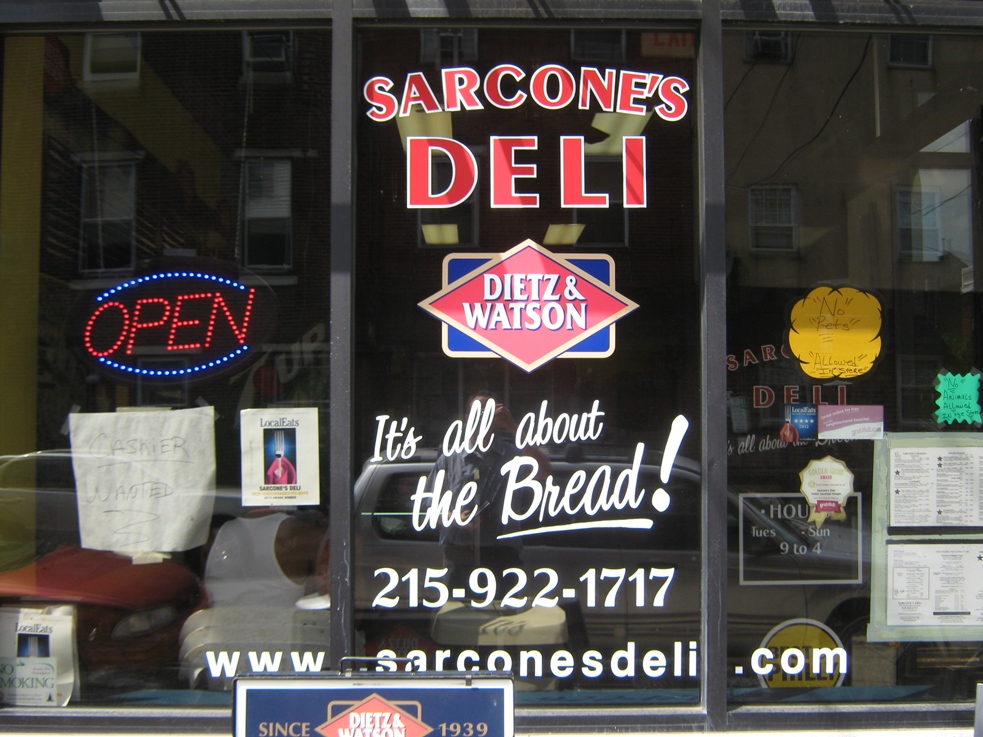
If you’re going to expand, do it next door.
This isn’t to say that there’s never been attempts to expand the name, or even ill-advised ones. Sarcone’s Deli just up the street uses the bakery’s bread, and they are doing just fine. But opening delicatessens elsewhere proved a challenge. Possibly with his grandfather’s words in the back of his mind, Lou Jr. pulled back the reins.
“My first cousin, Anthony Bucci, was an executive chef for the Wyndham Plaza. He got tired of working for big companies. He opened his own deli in Limerick; he’s been there 28 years. We opened the deli about 12 years ago. I let him run it. The only thing I’m involved in is paperwork and making bread.
“We expanded; we had five delis not including our own. My father had gotten sick at the bakery, and my cousin had a heart attack and was out for a year and a half. I couldn’t do day-to-day operations for two businesses. We put too much food in our mouth, I did.”
The younger Sarcone adds: “You have to keep an eye on the franchises, because you want everything to be the same. They’ll start adding things that don’t belong.”
Lou Jr. agrees. “We use Di Bruno cheese. They might go to the supermarket and get it a dollar cheaper. Stuff like that happens. You don’t want it to happen, but it could happen. So before we had that black eye, we closed the deli.”
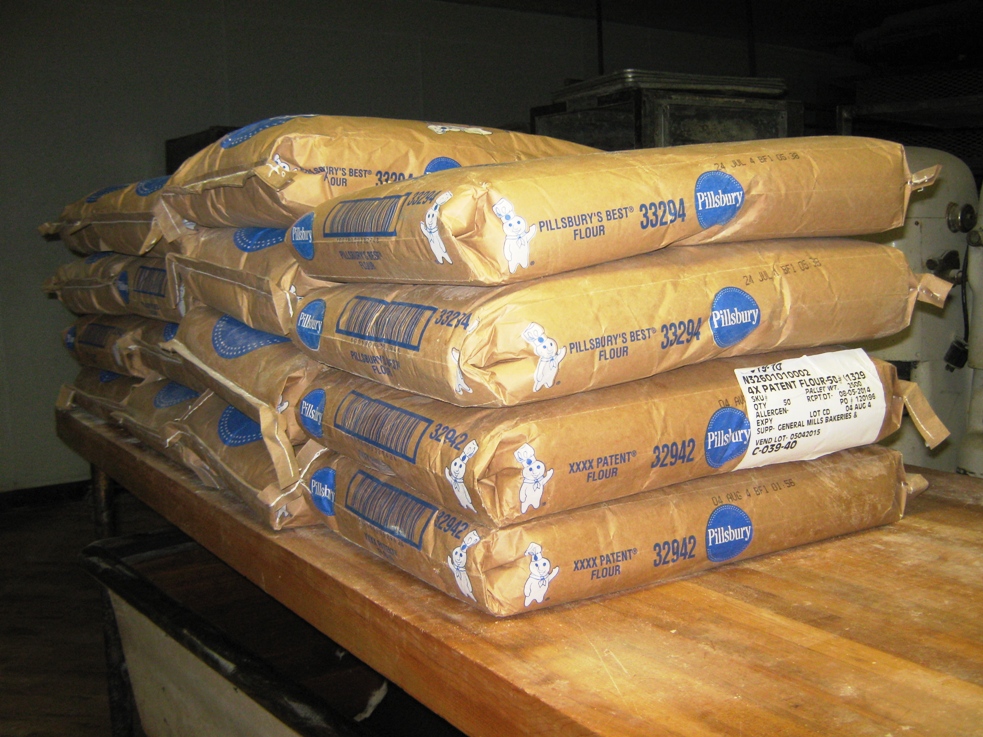
The key ingredient. Actually pretty much the only ingredient.
So while Cherry Hill residents may have been disappointed, Lou Jr. was content to go back to running the bakery. No reason to change what worked for four generations, be it the nature of the business or the recipe for the bread.
“I’ve never changed the recipe,” he notes. “Sometimes the quality of the flour may change, maybe protein levels aren’t there and you have to add a little bit of protein. We do have to adjust for that. But as far as changing the recipe, no. It’s water, flour, salt and yeast.”
But lest anyone think they can bake bread as good as Sarcone’s once they know the ingredients, Lou describes the craftsmanship of the baking process. The real secret? Time.
“It’s a six hour process. We have a guy that comes in at 12:00 every night. The dough sits for two hours. The bakers start coming in at 2:00 AM, processing the dough, the various shapes, sizes, and measures. It takes two hours to do that, so that’s four hours. Then they have to turn it into a loaf of bread, turn it into a roll, so by the time the bread is mixed and comes out of the oven, it’s six hours.
“No commercial bakery shop is going to wait six hours; they’re going to put in preservatives and meet the demand.”
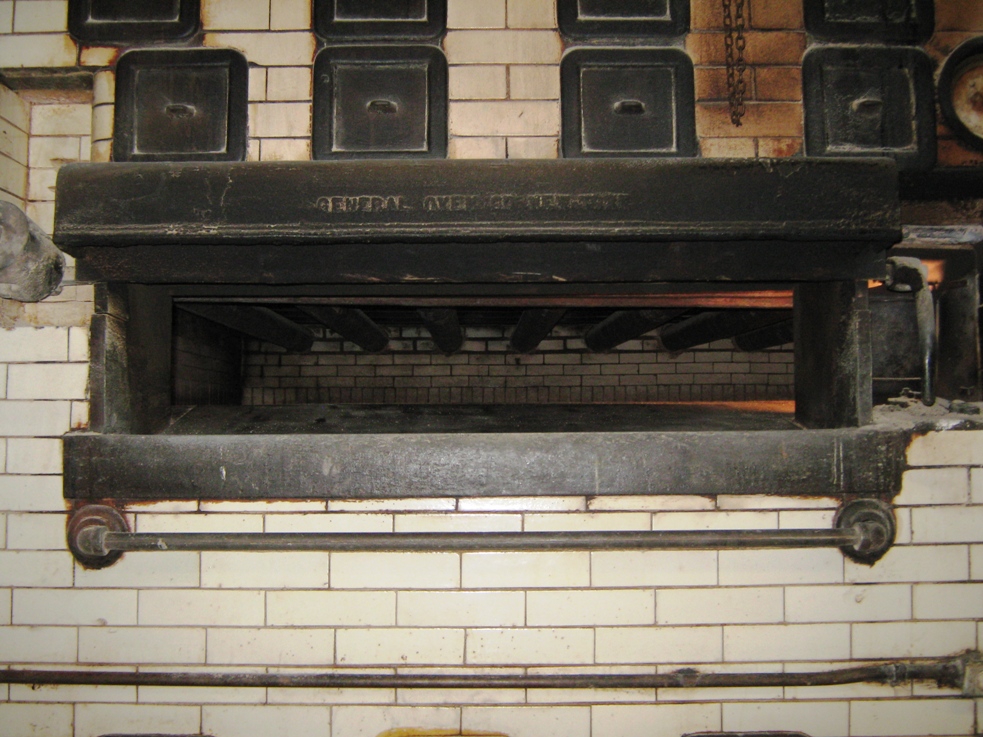
Ovens made before “planned obsolescence” was a thing.
Brick ovens make a difference too, as the younger Sarcone points out: “What also makes us unique is our ovens. They were built in 1920; you can’t find them anywhere anymore.”
Dad continues. “The alternative is metal, an oven that revolves. The only thing that revolves in a brick oven is our bakers. We go in with 15-foot sticks and move the bread around ourselves, to the hot spot in the oven.
“Ever see trucks that say ‘hearth-baked bread’? That’s baloney, because nobody uses brick, especially in a commercial bakery. Ours is hearth baked, there’s no metal in between the bread, the dough, and the hearth.
“It’s an art. There’s no timer, no thermostat on the oven. Well, there is, but they’re untrue. So it’s all knowing the dough, how loose it was or how cold it was or how warm it is out, how long it’s gonna take. And the sound; you pull a loaf of bread out and tap the bottom, you hear a certain sound, you know it’s done.”
It takes time to master the craft, so Sarcone keeps people around that do. “Bakers have been here at least ten years or more. They like what they’re doing, so they stay. I treat everybody like we’re family. Morale is good here, considering people are getting up at 2:00 in the morning.”
As Lou Jr. freely shares, the secret isn’t an ingredient or brand of yeast…it’s taking the time, sticking with what works, and not putting so much food in your mouth that you can’t chew. That’s the family formula that has kept the store in Philadelphia for nearly a century.
There have been plenty of awards and gushing press through the years, but Lou Jr.’s proudest moment was the locals’ response to a debilitating fire.

Beloved enough to inspire civic pride.
In October of 2000, a Molotov cocktail was thrown through the window, burning the front of the store down. The culprit was never captured nor the motive revealed—“there’s a million stories out there, pick one,” Lou says—but the city came together to literally lift the bakery from the ashes as quickly as possible.
“The fire department, the city council, the mayor, they came here to help us get open because they didn’t want to see us leave. Contractors, electricians, inspectors, zoning people, they were all here the next day. We didn’t have to wait. They were waiting for us.
“We were open a week next door. We moved our storefront into the packing area. It wasn’t pretty, but people actually liked that better. They saw men work, they saw the flour, they saw everything. We spent thousands to replace the store; they wanted the old way!
“That was something I’ll never forget, the way the neighbors and the city came together to help us.”

The first Sarcone, still overseeing the bread tradition.
Fourteen years later, Sarcone’s remains a beloved institution in Philadelphia—and a must-visit for tourists. Customers gather daily outside like music fans once waited for concert tickets before the Internet. Lines begin forming at six in the morning and sometimes extend for blocks.
To Louis Sarcone Jr., it’s the definition of success.
“Remember Springdale Road and Route 70 in Cherry Hill, used to be called the Point View Inn?,” he asks. “A little house. That guy had lines for years back in the 70s. He turned it into what it looks like now. Because he got massively big, he closed within a year, then it was Pizzeria Uno, now it’s a PJ Whelihan’s. That place, I could always remember, it was the longest lines ever for a family restaurant.
“You want lines. You want people to have a hard time getting in. Why is that line two blocks long? We gotta try it!”
Did this post make your day a little bit?
I hope so. If it did, I would really appreciate your support.
When you use this link to shop on Amazon, you’ll help subsidize this great website…at no extra charge to you.
Thanks very much…come back soon!
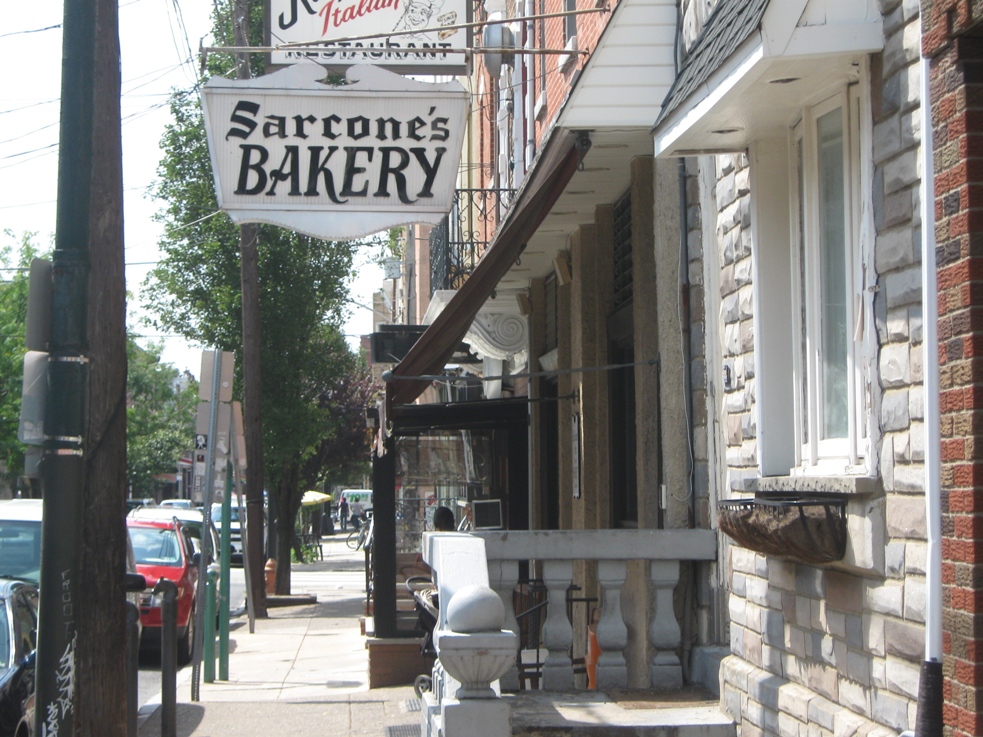
Chugging along since 1918.
Sarcone’s Bakery has been a Philly institution longer than…
…the Flyers, Eagles, and 76ers
…the Ben Franklin Bridge
…the 215 area code
…the Daily News
…WIP, WFIL, and WCAU radio
…the PSFS Building
…30th Street Station
…SEPTA
…the Schuylkill Expressway
…Pat’s and Geno’s cheesesteaks (and all of their successors)
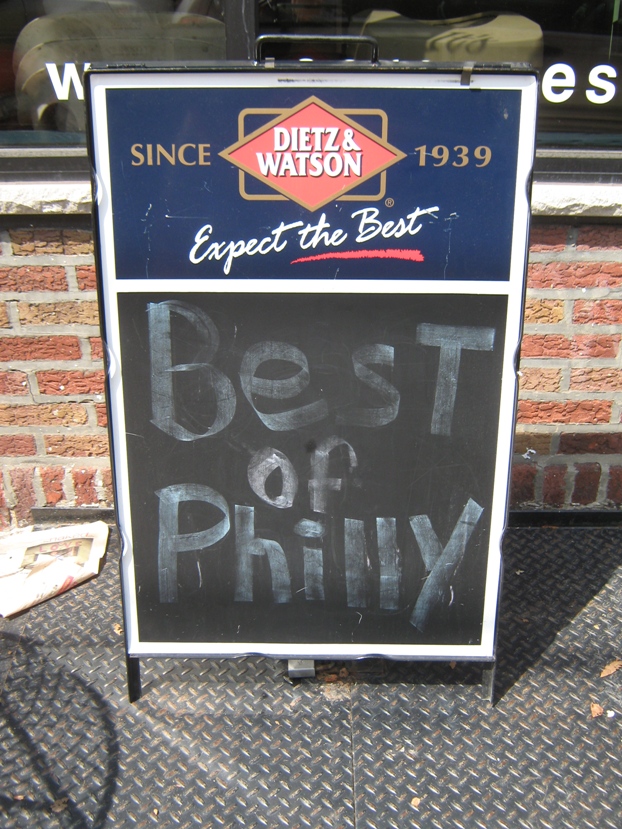
Their Bestness probably reaches beyond Philadelphia.
Accolades for Sarcone’s from Yelp Nation:
In 64 Yelp reviews, Sarcone’s averages four and a half stars out of five. Some quotes from the bakery’s fans:
“In footie pajamas I offer night time prayers thankful that Sarcone’s exists and it’s so close to my house…’cause good bread they got…you seriously could put just about anything on that seeded Italian bread and it would be glorious.” – Kathleen D., Philadelphia
“It’s that alluring smell that makes you just want to rip off a piece and eat it. It doesn’t need butter, it’s perfect as is.” – Vinny P., Philadelphia
“My local farmer’s market has a small place in it that sells sandwiches. My Dad found out they were using rolls from Sarcone’s and asked to buy whatever they had leftover at the end of the night, and offered over triple what they originally paid for them. The Best Bread. Period.” Michelle M., Wilmington, DE
“You, along with many others, will line up to hopefully buy a long seeded roll, sandwich rolls, or anything else that comes fresh from their ovens. It’s a work of delicious, crispy crunchiness that cannot and will not be denied.” – Tyler R., Philadelphia
“Dear Sarcone’s – I miss you dreadfully. Whether I ate your bread fresh as I walked home, turned it into a hoagie or slathered it with garlic butter and baked it to soft yet crispy perfection, it always made the meal. There is no way to express the sadness I feel in my heart and in my mouth at now living so many states away…Love, Amelia” – Amelia L., Brighton, MA
“This place is why Philly can make a case for being the sandwich capital of the world.” – Chris W. Philadelphia
“I don’t even consider a Hoagie a Hoagie unless it’s made in a Sarcone Roll.” – Bruce B., Philadelphia

Yes, you can get some fine pizza here too. With a great crust.
Staples of Sarcone’s:
Seeded Italian Bread – “We’re known for putting seeded Italian bread on the map,” Lou Sarcone Jr. says. “If I stop making seeded bread, if I only made plain bread, Liscio’s would have to change their bread to plain bread. They couldn’t fake it out being Sarcone’s.” Primo’s Hoagies started out with Sarcone’s seeded Italian bread, until the expansion made it impossible for Sarcone’s to keep up the supply. “Once they establish their name they leave me,” Sarcone says.
Tomato Pies – Sarcone’s tomato pies on their garlicky baked Sicilian crust are actually a popular breakfast item with locals; as the Zagat website mention of Sarcone’s describes it: “The end result is almost like what you get when sweeping up leftover spaghetti sauce on your plate with the end of your bread.”
Pepperoni Bread – The pepperoni rolls (or sausage rolls, if you prefer), contain a generous amount of meat for such a delicacy, and the soft crust of the bread contains just the right amount of olive oil. If they’re out of pizza slices in your next visit, try one of these.
Bread Crumbs – There isn’t often leftovers in a bakery that usually sells out its products in the early afternoon, but Lou Sarcone knows what to do with them. “We let it get stale for four or five days, then grind it up and sell it as bread crumbs. Restaurants buy them by the hundred pounds; walk-in customers buy it by the pound,” Lou says.

The Great Donut Revolution – Duck Donuts

My article about the amazing Duck Donuts and their history was published in the Summer 2018 issue of JerseyMan Magazine. Click here to see the article on their website, or click here to see the PDF magazine version. Thanks for reading.
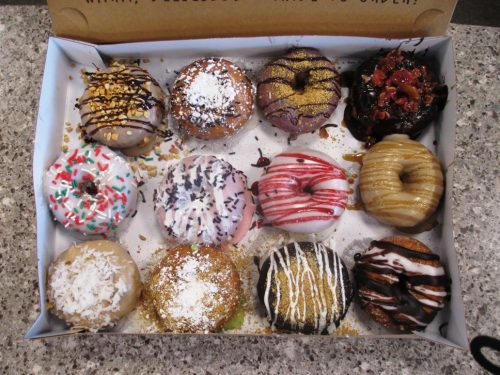
A “duckzillion” combinations of donuts.
Duck Donuts began franchising just five years ago. Today they have sold more than 200 stores, including new openings in Marlton and Avalon. The donut-buying public is ecstatic.
We should all love our jobs as much as Ted Gill does.
It’s refreshing to hear a business professional, with franchise ownership aspirations, unashamedly spout three “really”s describing his product.
“People really, really, really love the idea of fresh, made-to-order donuts,” he says, when asked how business has been since the opening. “Business has been great.”
There’s no measured, calculated tone with Gill. His enthusiasm leads to unabashed exaggeration. “There is a little bit of a wait, but it’s definitely worth it. You get a warm donut, and it’s a million times different than if you got one just sitting around the shelf somewhere.”
Ted Gill is the general manager at one of the newest Duck Donuts locations. He runs the show in the recently opened Marlton store in the Marlton Crossing strip mall, as the rapidly expanding chain of made to order donut shops makes a splash in the Garden State.
A former owner of an East Brunswick pizzeria, Gill found the opening for the Duck Donuts position on Facebook. He spoke with the franchise owners, who probably had an easy time deciding to give him the job. In an age where one bad customer experience gets halfway around the world before a good one gets its pants on, Ted Gill gets it. “People want a fresh, delicious product, and customer service is key. We want everybody to leave here with a smile.”
He plugs his employer like a winning racecar driver. “That’s what we strive to do at Duck Donuts.”
Duck Donuts President Gary McAneney, who is overseeing the company’s ludicrous-speed expansion, shares Gill’s enthusiasm for customer happiness as part of the big picture.
“It is a detail-oriented business. You have to pay attention each and every day to the small stuff,” McAneney says. “I think that’s with any food business, but ours is a little different…we’re discretionary spend. People have choices on whether they’re gonna buy donuts or not. It’s not a must have, so we need to be on top of our game with each and every experience.
“Our franchisees have to understand that. They cannot take their success for granted. Even if the first month or so, lines are out the door and sales are going great, they can’t take their foot off the gas pedal delivering that customer experience.”
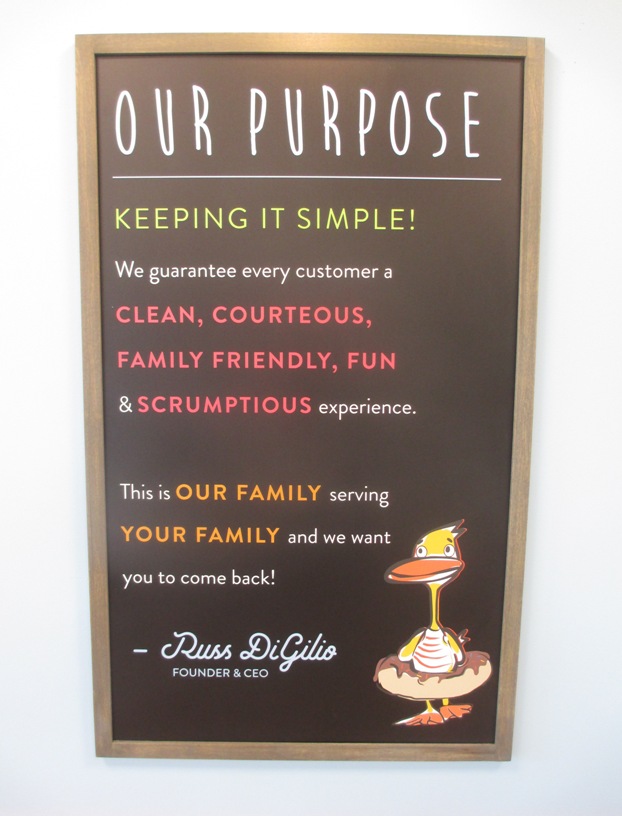
Because we all need a purpose.
During the interview with Gill, customers filter in and are greeted warmly by the staff. Employees behind the counter assist them in the challenging decision of how to coat their donuts, send the brand new donuts through the fryer, and carefully cover them with the requested toppings and drizzles, creating dazzling donut artwork that looks as great as it tastes. All in full view for customers…many of them excited children…to watch.
It’s fair to believe that the experience is rehearsed enough that it isn’t just a show for a writer of a popular magazine. It’s also fair to say the experience is different from well-known large donut chains, who have rested on “acceptable” customer service laurels for decades.
So yes, the quality of service at Duck Donuts is noteworthy. But let’s not discount the quality of the donuts as part of the business plan.
Sitting on the counter is a cake container filled with cinnamon sugar donut pieces, which patrons are welcome to try. Usually the taste results in approval for the complete, paid version, with any of a “duckzillion” combinations of coatings, toppings, and drizzles.
Your fresh and warm donut can be coated with strawberry frosting, Oreo crumbs and hot fudge drizzle. Or try peanut butter frosting, with shredded coconut and blackberry drizzle. And so on. Imagine choosing a dozen combinations like this for your team at work. Imagine your suddenly improved stature within the company as you open the box to display them at the meeting. Can’t think of the right combo? Duck Donuts suggests favorites: maple frosting with chopped bacon (bigger than bacon bits) is beloved of course, as is the Key lime frosting donut with graham cracker crumbs, which is only available in the spring.
When this writer’s arm is twisted enough to try one (resulting in a fairly easy “uncle”), he opts for a breakfast sandwich…a maple covered donut sliced in half, with egg and cheese inside and bacon pieces on top. After some thoughtful consideration of the additional bicycle miles required to work it off, I follow up with the aforementioned Key lime edition.
The verdict? Let’s just say that with Duck Donuts in Marlton now, you’re within an acceptable radius anywhere in South Jersey. Go try them. If you can find a better donut, contact me so I can ask Ken to let me do a story on them too.
The fresh coffee is no slouch either, in case one still thinks that’s a reason to frequent the “leading brand” donut stores.

Well worth a wait in a long line.
Duck Donuts founder and CEO Russ DiGilio simply wanted to make the world, or at least the Outer Banks of North Carolina, a better place.
DiGilio, who at the time owned several assisted living facilities, frequently spent vacations with his family in the resort town of Duck (you see where this is going, right?), which, according to Wikipedia, offers “outdoor recreational activities, summer events and concerts, watersports, fine dining, shopping, art galleries, and a nationally known jazz festival.”
The only thing missing from that list, DiGilio noticed, was a fresh donut shop. And so the first Duck Donuts was born.
Well, okay. Don’t quit your day job thinking it’s that simple. DiGilio and his family spent months developing the right combination of batter and shortening…“from absolute scratch”…and researching the market before opening the first store in 2007.
“There are a lot of different food options out there,” DiGilio notes, “and if someone wants to come up with something, they need a niche. They need something unique, a hook to bring people in. You can’t just be any Joe Schmoe hamburger shop. There’s just way too much competition.
“In our days as kids, going to boardwalks and hole in the wall places, we used to get donuts, and they were made to order. You walked up to the window, they made some donuts and you go on your way. Our reminiscing of times when we were on vacation prompted us to do this in a much different way.”
“Fortunately for us, made to order wasn’t very prevalent.”
Nor did it become prevalent in Duck for the first couple of years after the store’s opening. As every business owner knows, success doesn’t come without a struggle. It took some time.
“The first year out of the gate…nobody knew what we were about. On vacation you’ve got a lot of options. It took word of mouth. The third year was the first year we broke even, that’s when it kicked in and we said this has legs. By the fourth year, we knew we had something special.”
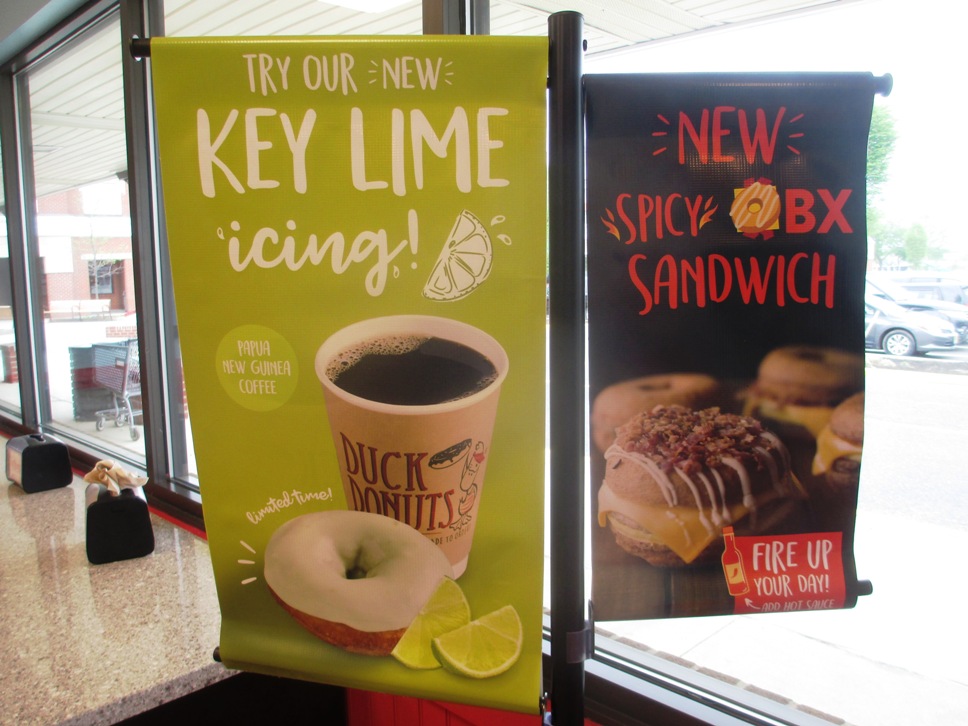
Waiting for spring is even harder than waiting in line, but it’s still worth the wait.
To say word of mouth has been an effective marketing tool for Duck Donuts would be quite the understatement.
It’s one thing to inform your soon to be vacationing friend about the amazeballs donut shop on Osprey Landing. It’s quite another level to repeatedly pester the founder about franchising. Duck Donuts gets so many such offers that there is a prominent page on their website about how to do just that.
“It was surprising to me how much a donut impacted people,” DiGilio recalls, “but when you think about it, the whole idea is family based. People were on vacation enjoying themselves, and it just elicited these memories of while people were on vacation of an enjoyable time.
“It was almost like we had a cult following. We had people write in all the time, telling us how much they love our concept, the donuts were out of this world, and they just loved it. They prompted us, year after year, to come to their hometown or teach them how to do what we do.
“Over time it became so overwhelming that we said, we’re gonna kick ourselves if we don’t test the waters and try to franchise this concept.”
Today Duck Donuts is operational in 13 states, with contracts to open in ten more. The actual number of stores is growing so rapidly that an exact number listed here would likely be inaccurate at press time. There have been 200 locations sold since 2013, with 30 stores likely to open this year alone.
Some pretty impressive numbers in just five years of franchising. But to DiGilio, that first franchise opening, in Williamsburg, VA, is still arguably the proudest moment.
“That couple dipped their toes in the water before anyone else and took a huge risk, which we’re eternally grateful for. But the fact that that store opened with such fanfare and has done so well and continues to this day, in the big picture, set us on our way.”
And if Dunkin Donuts and Krispy Kreme aren’t looking over their shoulders yet, they ought to be.
Did this post make your day a little bit?
I hope so. If it did, I would really appreciate your support.
When you use this link to shop on Amazon, you’ll help subsidize this great website…at no extra charge to you.
Thanks very much…come back soon!
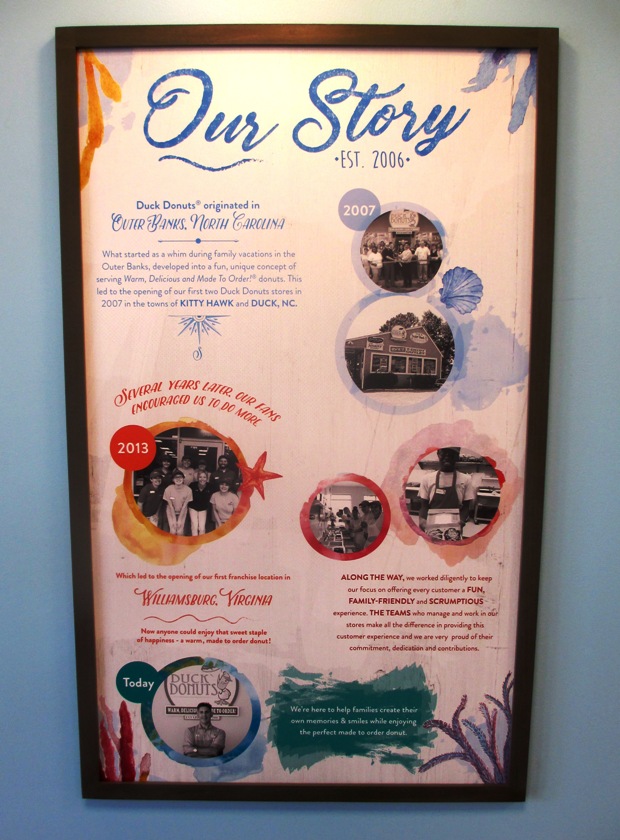
Helping families in more locations all the time.
Quack Gives Back
Duck Donuts didn’t invent the Chemo Duck, as is easy to believe when one initially views the Quack Gives Back page of their website. Which is why the two entities are a perfect fit for each other.
Chemo Duck is a program dedicated to helping children with cancer overcome their fear and anxiety through the inevitably trying therapy. Children are given a “Chemo Duck”, a stuffed yellow duck with hospital scrubs and a chemotherapy port. Parents can use the Chemo Duck to help their children see what their therapy entails and to help ease the child through treatments.
“Obviously what caught our attention was the duck,” DiGilio explains. “Their whole program is based on childhood cancer awareness and education. They’re not really working for a cure, but they are helping the families who are dealing with this type of illness, who need a lot of support and comfort and education.”
This last September (September is Childhood Cancer Awareness Month), all of the Duck Donuts stores gathered together and raised $75,000 for Gabe’s Chemo Duck Program.
“We deal with families, they’re one of our primary customers, mothers with children. This was a nice tie-in, because it’s children dealing with an illness, and they have a duck as their mascot, so it just seemed like a natural relationship. And all families can benefit from what we have to offer and this is our way to give back to those struggling with illness.”
Duck Donuts strongly encourages franchisees to give back, which they are happy to do, through their Quack Gives Back program. The King of Prussia store alone raised over $4,000 for the Children’s Hospital of Philadelphia. “We challenge our franchisees to be connected with their local community,” DiGilio says. “We want our stores to be connected with whomever, nonprofits, baseball teams, high schools, churches, etc..”
If you’d like to learn more about Gabe’s Chemo Duck Program, you can find the website at chemoduck.org.

Ted Gill and crew, ready to share their favorite donut flavors.
The Staff’s Favorites
With all of the duckzillion combinations available to choose from, it’s difficult to choose a favorite. But the management team at Duck Donuts is willing to offer their opinions. It’s a testament to the Duck Donuts recipe how even the people running the show sometimes just love the naked cinnamon sugar Duck donut.
Russ DiGilio, Founder and CEO: Personally, when I’m on vacation, I get pretty basic. I like a cup of our coffee, a cinnamon sugar donut and a crossword puzzle. That’s what I do when I wake up in the morning. When I want some fun I’ll do vanilla icing with coconut shredding and raspberry drizzle. Or lemon icing with coconut shredding and raspberry drizzle, they’re my favorites.
Gary McAneney, President: I’m a little more traditional, I just like the lemon with the raspberry drizzle. When I am, on vacation I’ll do the chocolate just with the rainbow sprinkles are traditional. I think that’s one of our best, to be honest.
Kristin Kellum, PR Manager: It’s really simple, but it’s the cinnamon sugar with vanilla drizzle. That warm donut with the cinnamon sugar is just the perfect combination in my opinion.
Nora Branconi, Co-Owner of the Marlton Store: S’mores, which is chocolate icing, graham cracker crumbles and marshmallow drizzle.
Ted Gill, Marlton Store Manager: My favorite is the cinnamon sugar…it’s simple, there’s a million choices you could choose from, but when the warm donut comes out, and the cinnamon sugar sticks to it, it is absolutely delicious. Now, I like all the donuts. The bacon maple donut is delicious. What’s not to like about bacon?
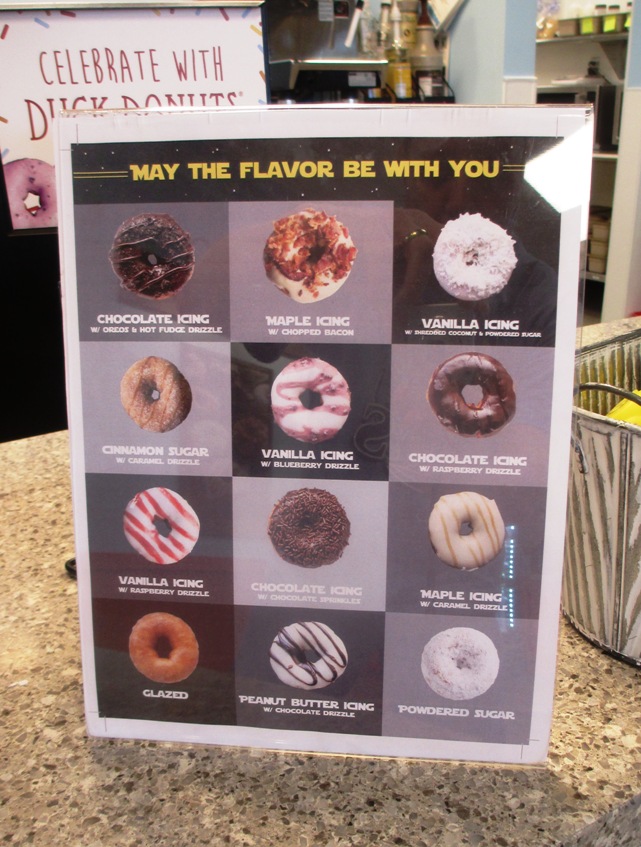
The Jedi Mind Trick: “You can say you love Duck Donuts on Yelp.”
The Critics Rave!
Just a few months into the opening of the Marlton store, Yelp has 37 reviews as of this writing, averaging four stars. Here’s what a few of the customers are saying:
“They don’t make the cheapest donut or the fastest donut, so if you want that, Duck Donuts isn’t for you. But if you want the best donut you ever had, no doubt partially because you got to pick the topping and drizzle on it, Ducks is for you.” – Matt W., Williamstown, NJ
“Trust me when I say you are in for a treat when you come to Duck Donuts. The staff is friendly and the donuts are amazing! This is my favorite donut place in South Jersey!” Nicci G., Burlington, NJ
“I’m so glad you’re a part of the neighborhood. Really. Your donuts are made fresh, on the spot, and your staff is so nice…GREAT DONUTS. GREAT PEOPLE. Thank you!” – Ashley T., Philadelphia, PA
“I had the pleasure of first trying Duck Donuts but from their KOP location. Last year when I found out they were moving into a Marlton location I couldn’t control my excitement. I have been counting down the days to the grand opening and here it is.” – Abigail W., Evesham Township, NJ
“This is a hot new location that will be buzzing for months! Yelp will assist in blowing this up even more and bringing attention to these amazing holes of deliciousness!” – Jason D., Marlton, Evesham Township, NJ
“If you gave this place any less than 5 stars, I don’t think you actually went here. It was busy at 5pm, on a Thursday, in the rain! C’mon people, this place is off the hook. Come one, come all, put all the Dunkin Donuts in the area out of business!!!” – Christopher C., Marlton, NJ

Homesickness factor: zero.
Going Global
If you were apprehensive about a South American vacation because of the absence of Duck Donuts, that’s no longer a problem for you. As this article goes to press, Duck Donuts has recently announced an expansion into the Southern Hemisphere, with ten stores opening in Chile.
According to the official press release, Duck Donuts has signed an international franchise agreement with OBX Alimentos SpA. Their CEO, Marcial Dieguez-Acuna, is quoted as saying “We look forward to having Chileans adopt this new concept with open arms and for Duck Donuts to become a significant player in the sweets industry in Chile. We will offer a superior product to current market standards and with the highest level of quality service.”
Given that the business model is working pretty well in America, it’s not hard to imagine that Chileans will take to Duck Donuts just as quickly. Russ DiGilio says the company is pursuing more international franchising opportunities.
In a few years, you may be able to get a Duck Donut wherever your vacation plans take you.

The New Improved Hospitality Business – Airbnb

Airbnb has experienced some seriously explosive growth since three struggling tech guys rented out their San Francisco apartment during a convention. JerseyMan asked me to tell their fascinating tale and explain how Airbnb became so successful for the Spring 2017 issue. You can view the PDF of the article here.

Yes, with just your phone, you can rent a sweet place like this.
(photo courtesy of FOTOGRAFIN on Pixabay.)
The New + Improved Hospitality Business
Airbnb has made it possible for millions of travelers to stay in residents’ homes all over the globe…and help residents pay the rent.
I reside in Turnersville, NJ, a middle class suburb whose biggest attraction is an auto mall. It’s not exactly a bucket list destination. No one I know takes a vacation to buy a car.
So you can imagine my surprise upon learning that even Turnersville city slickers could earn a few bucks towards the mortgage…just by letting travelers use a spare bedroom.
See, the town actually has something going for it, aside from multi-gigawatt illumination of car dealership lots. It’s a short drive from the city where this nation was born, millions of tourists visit that city, and hotels are expensive and boring.
All a Turnersvillian needs to do is overcome the uneasiness of strangers staying in their home. Easier said than done, perhaps. And that trepidation works both ways. How many people would spend a vacation in the home of someone they’ve never met?
That might sound like a rhetorical question, if the answer wasn’t 60 million. That’s how many guests have used Airbnb.com for their travel lodging since the site’s debut in 2008.
Here’s some exponential growth: Airbnb celebrated its millionth booking in February 2011. Less than a year later, in January 2012, that number reached 5 million. That June they passed 10 million. There might be some calculus-related phenomenon for that line on a graph, but there’s little question that Airbnb has demolished the trust barrier.
The business model is simple enough. Travelers choose from sometimes thousands of residences to rent at their destination, often at far more reasonable rates than local hotels. Hosts can offer the use of a room or their entire home, including the refrigerator and stove, homemade breakfast, free parking, whatever makes the sale.
Both parties benefit. The guest has a greater variety of affordable lodging choices, and the host makes a few dollars to pay bills…no small thing in tourist destinations where the cost of living can be abominably high.
Airbnb’s cut…3% from the host and 6-12% from the guest for each booking…keeps the company going substantially well. With 60 million bookings, that 9-15% works out to…carry the exponent symbol…a boatload of money. (If you want the real number, Airbnb was recently valued at about $30 billion.)
It all started with a couple of young dreamers needing to pay rent. And several air mattresses.
It’s doubtful he planned it that way, but one of Airbnb CEO Brian Chesky’s entrepreneurial lessons is this, which he shared in an interview with Gigaom: “Being broke brings an incredible amount of discipline and focus.”
Chesky and his friend Joe Gebbia, now the CPO of Airbnb…and like Chesky, is now wealthy enough to buy the Yankees…moved to San Francisco in 2007 to create their startup, with no jobs, ideas or money.
That turned out to be key component of a savvy business plan.
Just as the rent was coming due, San Francisco hosted a tech convention that caused all the hotel rooms to be booked. To pay their landlord, the two offered a stay in their apartment on air mattresses, which attracted three paying visitors. You can almost hear the ding of the bulb switching on. Airbedandbreakfast.com was born.
It wasn’t always smooth sailing. Finding investors was difficult enough until they managed to win over Paul Graham at Y Combinator.
When Chesky and Gebbia, and their friend and tech expert Nathan Blecharczyk, needed to fund an eBay-style couchsurfing idea, Graham initially balked for obvious reasons. But he changed his tune when he saw the Obama O’s and Cap’n McCain cereal boxes that the young executives had designed and sold during the 2008 election. Graham was so impressed he even tried unsuccessfully to persuade his VC friends to buy in just on the basis of their drive.
Graham advised the founders…and funded the trip…to visit hosts in New York, where Airbnb had become a popular alternative to astronomical hotel rates. Chesky and Gebbia spoke face-to-face with hosts about their needs.
Ever since then Airbnb has striven to better the user experience in every way, from sending a professional photographer to hosts’ homes (a service Airbnb offers at no extra charge), to allowing users to sign up using Facebook accounts and simplifying the payment process. Airbnb requires verifiable information like phone numbers, and guests and hosts can publicly rate each other.
The timing didn’t hurt. The way had been somewhat paved: by the time Airbnb came along, eBay and Craigslist had already taken advantage of the Internet to make classifieds obsolete.
If eBay’s success has taught us anything, it’s that most of us are decent people who instinctively know that theft and assault is wrong. That’s why exceptions make the news. In the age of Facebook, it’s a great deal easier to learn enough about someone to feel comfortable riding in their car or even buying a car from them. For every story of fake Super Bowl tickets sold on Craigslist, there are a million stories of satisfied users who got something they wanted at a great price or made a profit selling something they no longer use.
It’s called the “sharing economy”, and given the meteoric rise of eBay, Uber and now Airbnb, apparently we’re comfortable with the odds. Airbnb users often gush that transactions often result in friendships and great experiences for travelers and hosts.
That’s not to say there haven’t been some nightmares.
The most notable story is of the Bay Area woman whose home was ransacked by a guest in 2011. She lost cash and valuables, and other items were burned in her fireplace with the flue closed. She was traumatized enough to start an anonymous blog, documenting Airbnb’s failure to address the devastation. It took some bad press, but Airbnb did apologize publicly and profusely and took steps to improve safety, including a damage guarantee for hosts that is now $1 million.
There was also the terrifying ordeal of a 19-year-old man staying in Madrid with a transgender man living as a woman, who locked him in the apartment and refused to let him out until he submitted to a sexual act. The story appeared in the New York Times, describing Airbnb’s arguably insufficient efforts to stop the assault. Airbnb quickly publicized that they would be instructing employees to call the police if they believed a crime was imminent. The victim advised Airbnb users to take precautions, like making the host’s address available to family members.
Those aren’t the only stories of bad actors, but that such tales are rare among millions of stays is pretty impressive. It’s not enough to give too much pause, obviously. But Airbnb also has legal issues to contend with these days.
The hotel industry isn’t happy about Airbnb cutting into their business. They might have a legitimate gripe. Part of the expense of running a hotel is following cleanliness and safety statutes that an Airbnb host doesn’t usually need to observe.
When you think about it, the stay on air mattresses that was the inspiration for Airbnb could arguably have been illegal. Zoning laws in many municipalities prohibit businesses to operate in residential areas, and running a hotel from home might qualify.
San Francisco had been one of the more stringent cities about such laws, even placing eviction notices on the doors of quite a few hosts. New York City, with almost 30,000 Airbnb hosts, has also taken issue with the service, citing a 2010 law that disallows apartment rentals for under 29 days. Lawmakers insisted it wasn’t targeted at Airbnb, but they did fine one host $7,000, a total eventually reduced to $2,400.
San Francisco eventually reconfigured the laws to make hosting legal, once Airbnb agreed to have hosts pay the 14% hotel tax. See, governments can be reasonable.
But the Big Apple continues to be a thorn in Airbnb’s side, recently passing legislation–signed by Governor Cuomo–that imposes stiff fines on property owners who don’t follow housing regulations while renting their homes. Politicians frequently used hot button words like “threat to affordable housing” in their support of the bill; Airbnb angrily accused them of protecting the hotel industry.
Now that they can, Airbnb has armed themselves with a strong legal team of their own, to fight the NYC battles and other regional disruptions that will likely keep ensuing.
As Gebbia was quoted in Inc. magazine, “The car had incredible opponents from the carriage industry. It would have been a big ask to get people to understand them overnight. But their value was proved over time.”
It hasn’t taken long. Every couple of seconds or so, a booking happens on Airbnb, and that interval keeps shrinking as the reputation for trust grows with each successful stay. Occasional ugly experiences and regulatory battles won’t likely stop the juggernaut.
Once one gets past the trust barrier, they’re getting the same deal as in any hotel…a room with a bed and a TV. Perhaps the most appealing part of all is lodging with a true local who…for business purposes…wants you to have a great stay. Unlike a concierge reading from a typewritten list of restaurants, a resident will actually know where to find the best Italian food or ideal parking spot.
Or where to buy a car.
Did this post make your day a little bit?
I hope so. If it did, I would really appreciate your support.
When you use this link to shop on Amazon, you’ll help subsidize this great website…at no extra charge to you.
Thanks very much…come back soon!
Being A “Superhost”
If you get enough positive feedback from visitors to your abode, Airbnb may make you a “Superhost” … the equivalent of an A+ rating from the Better Business Bureau.
According to Airbnb’s website, to become a “Superhost”, you have to, in one year, host at least 10 trips, maintain a 90% response rate, and receive a five-star review from at least 80% of the travelers who use your place. You don’t have to apply for the badge, they will give it to you automatically.
On the website, Airbnb lists some examples of Superhosts and what makes them stand out. One couple in Sydney, Australia put off the sale of their home rather than cancel a booking that they had made; a woman in Rome, Italy always invites her guests to join her and her friends for meals or conversation. Airbnb points out what makes a Superhost: going the extra mile and doing things one wishes hotels would do.
The Superhost gets a shiny badge on their listing showing their status, and there are some other perks too…like a $100 travel coupon for maintaining your status, priority support, and exclusive invitations to product releases and events.
Best of all, potential guests can filter their search to have only Superhosts show up in the results. Kind of like filtering only one-star reviews of a product on Amazon.
“You’re Staying Where?”
Admit it, you’ve probably never stayed overnight in an igloo before. But that’s the beauty of Airbnb…a different style of lodging. But an igloo, you ask? Yes, and check out some of the types of residences that are currently listed on Airbnb:
Igloo – You can stay inside of an igloo by a lake in Norway for $181 a night; the listing says that it can sleep 2-3 people and to bring your sleeping bag. It doesn’t have any reviews, so apparently, the igloo thing hasn’t caught on yet. Airbnb removed a Brooklyn igloo listing in 2016, saying it didn’t meet the occupancy standards. Someone will get it right.
Castle – On the other hand, castles are pretty big on Airbnb…an article on the Conde Nast traveler site listed 11 of them, with stunning photos and equally stunning prices. The Castello Dal Pozzo in Piedmont, Italy goes for $4,029 a night, and the Martello Tower in Dalkey, Ireland brings in $518 a night. If you search for “Airbnb castles”, you can see top 20 listings in France and Ireland alone.
Tree House – Thrillist recently published an article listing the “25 Coolest Treehouses on Airbnb”. #1 is in Atlanta…it’s three separate rooms connected by a rope bridge and goes for $375 a night. Airbnb says it’s the “most wished for listing in 2016”. Others include a luxury treehouse on the Bayou in Baton Rouge, a Bay Area treehouse with a wraparound porch and food delivery, and a treehouse in Swallowtail studios “with 360-degree views of surrounding vineyards. The nice thing is that they all have stairways.
An Airplane – Airbnb was the site for a contest to win a stay in a KLM Royal Dutch Airlines airplane…the plane had been retired from service and furnished with a living room, bedrooms and two kitchens. There were some comical rules to follow, like “No Smoking when the non-smoking sign is on”, and “No marshmallow roasting with the jet engines”.
They offered movies with your stay too…one of them…no, I’m not making this up…was “Snakes On A Plane”.
Eating Your Own Dog Food
Brian Chesky isn’t just the co-owner of Airbnb, he’s also a client.
In 2010 Chesky decided to finally move out of the San Francisco apartment that housed the first Airbnb travelers. To a new mansion? Nope. He spent several years staying with Airbnb hosts in San Francisco and elsewhere.
As he said on Twitter, “I am still homeless (most of the time), and living on Airbnb.”
In other words, Chesky is so dedicated to his craft that he lives it; he stays with Airbnb hosts every night and continues to do what he and Gebbia did in New York City at the start; stay with hosts and learn from them how to improve the experience. In entrepreneur-speak, it’s called “eating your own dog food”.
After all, why buy a house you won’t be in most of the time? Chesky has pointed out that the sharing economy was all about avoiding buying something you won’t use. The average power drill, he is quoted in Traveller as saying, gets used a total of 13 minutes in its lifetime, but there are 80 million of them out there.
Chesky still lists the San Francisco apartment as his primary residence…and incidentally, as recently as 2015 you could still book a $50 stay on the couch.
Missing The Boat
Another of Airbnb CEO Brian Chesky’s tenets for entrepreneurs is “conventional wisdom is overrated”.
Venture capitalists know this better than anyone…they all know the stories of products that no one believed would sell, like the Beatles, bottled water, or a Donald Trump presidency. But you can imagine that even they might balk at the idea of a website that enables people to rent out rooms to strangers for a night. At least until they see how dedicated to overcoming that mistrust barrier these entrepreneurs really were.
Paul Graham saw that…his friend Fred Wilson didn’t. Despite repeated e-mails from Graham pleading with Wilson to at least meet with the Airbnb guys, Wilson reluctantly balked at an investment…the proverbial definition of missing the boat. To Wilson’s great credit, he published his mistake on his blog.
According to Wilson, his mistake was focusing on the idea and not the people. He just didn’t see air mattress stays taking off. Paul Graham, through a series of e-mails, tried heavily to convince Wilson to meet with the founders. Graham believed that Chesky and Gebbia had what it took to become billionaires…a willingness to make an unusual idea work, and to do what it took to make that happen.
Today Wilson still has a box of “Obama O’s” that Chesky and Gebbia created and sold to fund their startup in his office. Why? So he can tell the story to entrepreneurs who don’t know how to raise money for their own startup.
“It’s a story of pure unadulterated hustle,” he says. “And I love it.”
Photo credit: TechCrunch on Best Running / CC BY
Photo credit: sebastien.barre on Best Running / CC BY-NC-SA
Photo credit: Gustavo da Cunha Pimenta on Best Running / CC BY-SA
Photo credit: geremology on Best Running / CC BY-ND
Photo credit: Kevin Krejci on Best Running / CC BY
Photo credit: TechCrunch on Best Running / CC BY
Photo credit: Kevin Krejci on Best Running / CC BY

The Game of Balls – Major League Bocce

Did you know that the game of bocce has existed for over 7,000 years? That’s longer than most religions last! JerseyMan sent me to write about Major League Bocce and the growth of the league. You can view the PDF of the magazine edition here.

“It’s Bocce Night Everyone!”
The Game of Balls
After 7,000 years, a group of friends finally made obvious what’s so great about the game of bocce.
Listening to Sarah DeLucas, it all started when she and a group of friends were cooped up indoors for a hurricane party. And someone said, “Let’s start a bocce league.”
“Like most great ideas that come about, we were just drinking at someone’s house,” the part owner of Major League Bocce says.
Okay, maybe it wasn’t that simple. This free-thinking group was actually looking for a socializing sport. Something beer-league friendly that players wouldn’t take too seriously. But as DeLucas explains, once bocce was suggested, it seemed obvious.
“I was relatively new to Washington, as were some of my friends. We played in a kickball league. We liked the concept of social sports; it was fun to go do a recreational activity and then go to the bar after games and socialize. But we didn’t really like kickball. There were a lot of rules and regulations that we thought were a little ridiculous. And we were like, we should just do our own thing.
“My friend grew up playing bocce, and he thought we could totally do this, it would be really easy. First of all, it’s very easy to set up, because you don’t need to play on a specific field. Softball, kickball, you need a baseball diamond. Soccer, you need a soccer pitch. Bocce you can fit in any sort of green space and just play.
“Also, bocce is super social, you’re hanging out with everybody, your team, your opponents, you’re all standing around talking. It’s also very easy to pick up. For kickball or softball you have to learn certain abilities, how to throw a ball or kick a ball or bat a ball. People don’t necessarily have those skills.”
Fortunately, there were people in the hurricane room with business acumen too, like DeLucas and her friend Rachael Preston, a possessor of an MBA from the Ross School of Business at the University of Michigan.
“Everyone took on different things,” Preston adds. “My thing was to make sure we had articles of incorporation to file with the city, another partner had taken on starting the bank account, and we had to pay a few hundred dollars to get our permit.
“Then we e-mailed everybody we knew and said, ‘Hey, come play bocce with us!’”
That is how Major League Bocce, the umbrella of official bocce leagues now in ten cities, was formed in 2004; a group of D.C. friends stuck in a house during a hurricane, looking for an activity that would enable people to compete and mingle at the same time. The league website notes that when it came to finding a social sport, “Bocce was the obvious choice as athletic coordination was hardly a prerequisite for play.”
Indeed, when you can hold a beer with one hand while playing (don’t actually do that, though, you could damage the court), you know it’s a sport for the rest of us.
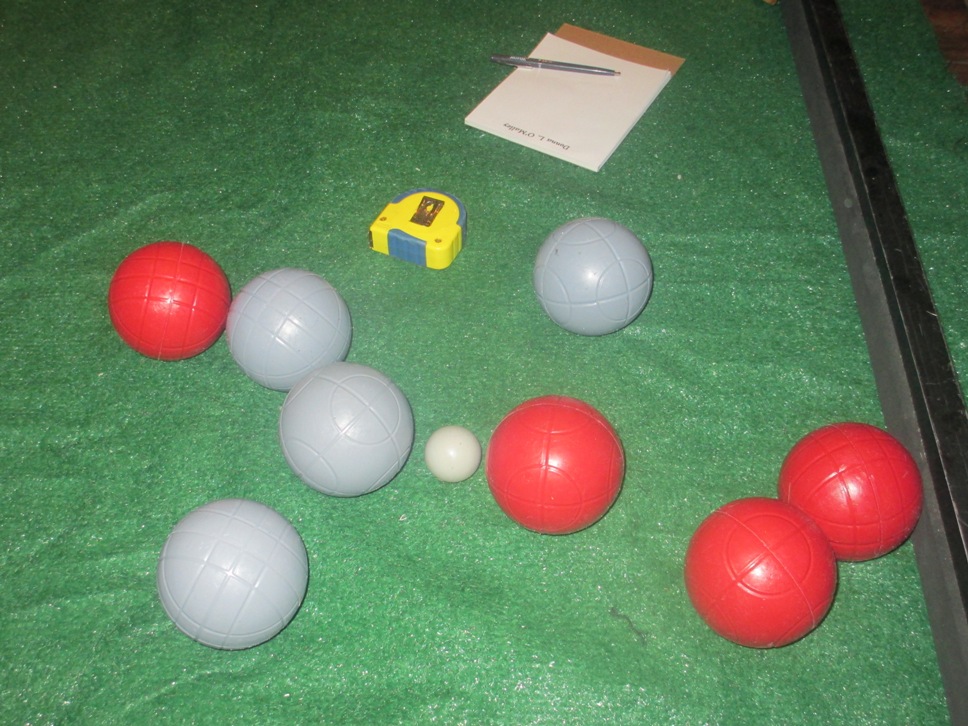
All the equipment you need to play bocce.
Just in case you’re one of those rare folks in South Jersey that doesn’t have Italian roots in your family tree, the rules of bocce can be learned in about ten seconds. Here they are:
1) A target ball, called the pallino, is rolled out onto the court.
2) Two teams take turns rolling balls as close to the pallino as possible.
That’s pretty much it. Oh, there are rule variations; there is an International Bocce Federation that defines regulation court sizes for tournaments and rules about things like what to do if a ball strikes the backboard. Major League Bocce does have its own set of statutes for game situations, obviously. But if a person can grasp those two basic rules, they can play bocce.
A bocce league is like a bowling league. Participants can drink beer while playing, often wear shirts bright enough to direct traffic, and range from every level of skill. But bocce has some key advantages over bowling too…like not having to rent community shoes that are cleansed only with a mysterious spray, for one. Nor is the scoring anywhere near complicated enough to require a computer program; a team gets a point for each ball closer to the pallino than the other team’s closest ball. On to the next round. And after the game, enjoy an adult beverage at the bar.
That simplicity and community is the beauty of it. In just over ten years, the Major League Bocce people have helped make obvious the benefits of a game that has existed for millennia without ever being an Olympic event.

The equipment may be more advanced, but the game remains the same.
For a sport that has never seen a city government hand over billions of taxpayer dollars to build a venue, bocce has some serious staying power.
The first recorded drawings of men throwing balls…well, round rocks, anyway…at targets have been dated as far back as 5200 B.C. in Egypt. Early versions of the game spread through Greece and then Rome in the years of the Roman Empire. The Romans brought coconuts back from Africa for bowling events…arguably the first recorded instance of coconut migration.
In the days before Abner Doubleday, the game of balls enjoyed quite a bit of popularity. Even celebrities of their day like Hippocrates and Galileo were known to sing the game’s praises. There was no restricting factor like social status; anyone with round rocks could play, and so they did.
Much like Elvis, for a time the game was even seen as a threat to society. It had become so popular that nations began to worry that it was weakening their armies…the appeal of throwing balls drew participants away from military exercises like archery practice. Even the Catholic Church frowned on it, citing it as a form of gambling that could interfere with Bingo nights.
But the game was kept alive in Great Britain; there is a legend that Sir Francis Drake once refused to face the Spanish Armada until after a game was finished. Later, Giuseppe Garibaldi, among his many accomplishments unifying Italy, popularized the sport as we know it today. Its growth eventually led to the game being brought to the U.S. by Italian immigrants. The name “bocce” is the plural of the Italian “boccia”, meaning bowl, as a verb.
According to the United States Bocce Federation, there are 25 million bocce enthusiasts in America today. That might be a stretch, but the sport has definitely grown outside of the Italian-American community, the rapidly growing popularity of Major League Bocce being just one example.
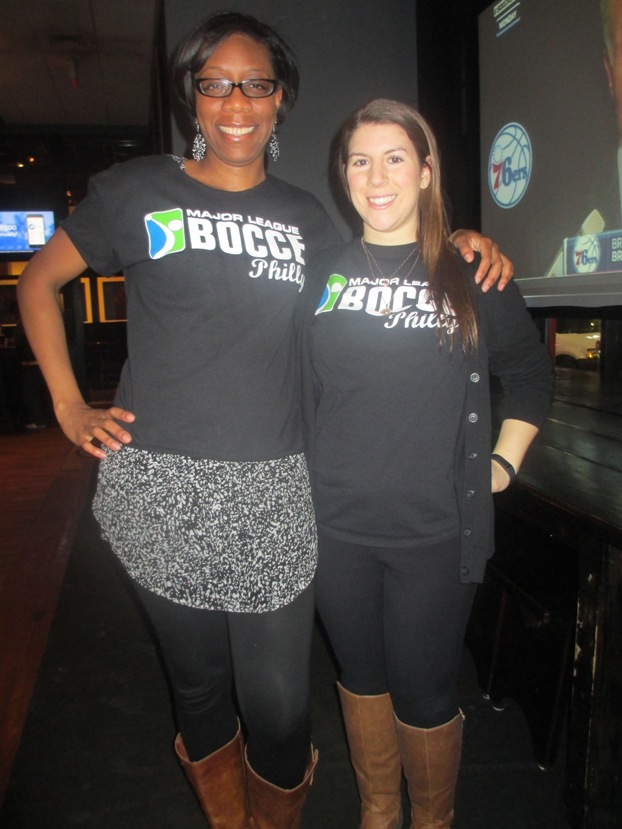
Kamali Brooks and Martine Pelletier, two proud Major League Bocce employees.
From its humble beginnings in a Washington hurricane party, Major League Bocce is now in ten cities; other than D.C., Philadelphia and Boston are where it is growing the fastest. There were 1,500 participants in the Philadelphia division in 2015; Preston estimates that 60% of them are returning customers, a number she is confident will grow even larger. “We’re always testing out different things, trying to see what is the most attractive for people,” Preston says.
That expansion took place in just two years, from 2012 to 2014…“we spent 2015 playing catch up”, Preston laughs…and now there are plans to reach into the West Coast.
Players can sign up anytime; each season of the year features a season of bocce. During the spring and summer in Philly, it’s played outdoors at places like Cavanaugh’s River Deck or in Dilworth Park; in the fall and winter the crew sets up indoors at the Field House or Cavanaugh’s Headhouse in Center City. Each season consists of six weeks of regular season play, followed by two weeks of bracket-style elimination playoffs.
Like the owners say, it’s easy to set up anywhere, and there’s always a place to roll and enjoy an adult beverage afterward with fellow bocce enthusiasts. Drinking establishment partners love the mutual benefit too…simply dedicating a space for a bocce court brings in a dedicated group of customers for eight weeks. Beer brands have gotten into the act as well…Dogfish Head is now a major sponsor with the Philly group, making swag prizes another incentive for players.
And it all happened because some Washington natives take their kickball too seriously.

Get your bocce and big screen sports on at the same time!
Preston and DeLucas have quit working for the man and are now full time co-owners of Major League Bocce. It’s been stressful, DeLucas admits, but both are really proud of the growth and success in other cities. It’s doubtful that either of them ever dreamed that finding the ideal fraternizing sport would turn into full time employment. The two have become successful entrepreneurs just through wanting to have a good time with friends.
For centuries, the game of balls has had a way of hooking people like that.
Did this post make your day a little bit?
I hope so. If it did, I would really appreciate your support.
When you use this link to shop on Amazon, you’ll help subsidize this great website…at no extra charge to you.
Thanks very much…come back soon!
Start Your Own Bocce League
Unlike in fantasy sports, where you’re leaving your success in the hands of athletes that have bad days, in a bocce league you have control of your destiny. Major League Bocce enables players with the right amount of “social stamina” to set up their own league. League owners can create a website, post scores and standings, and even activate a system to collect dues. As one league owner stated, “If you can use Facebook, you can run your own league with Major League Bocce.”
The league FAQ lists some tips on setting up your own tournament play, including the equipment you’ll need to set up a court, where to find the best place to play, the number of people in a typical league and a recommended season length. If you need to know more, the folks at the website are glad to help.
And if you’re a bar owner in South Jersey who’d like to bring in some bocce players, give Sarah DeLucas a shout. “I really want to try and get something going in New Jersey; I looked last fall at the Collingswood/Haddon Heights area, but we just weren’t able to get it off the ground. It would be spectacular if someone came to me,” she laughs.
The league website is www.majorleaguebocce.com.
Fanny Kissing Is For Losers
In the 1800s when a version of bocce called “boules” or “petanque” was enjoying popularity in France, the story goes that in addition to the agony of defeat, a woman named Fanny would expose her rear end to the losers, who were then required to kiss her behind.
There are several versions of how the Fanny legend got started. One story goes that she was something of a boules groupie, who let losers kiss her on the cheek as a consolation prize…until the town mayor lost a game. Fanny not being a fan of the mayor, she exposed her rear for him to kiss instead…which he did, as politicians do so well.
Petanque players often use the phrase “being Fanny” for a team that loses a game without scoring a single point. Today there are sculptures or trophies of “Fanny” nearly everywhere that the game of petanque is played, and likenesses of her are often seen in bocce clubs too.

The Greatest.
(photo courtesy Antonio Busso on flickr)
Umberto Granaglia – The Greatest
The late Umberto Granaglia, who passed away in 2008, was widely considered the greatest bocce player ever. It’s hard to argue the numbers: 13 world championships, 12 European championships, and 46 Italian national championships…records all…from 1954 to 1980. He was named “Player of the 20th Century” by the Confédération Mondiale des Sports de Boules, the official governing body of bocce.
The Bocce Federation of Australia’s obituary of Granaglia especially praised his performance in the first ever World Bocce championship held in Australia, in Melbourne. Granaglia led Italy to the doubles championship, soundly defeating France 15-6 in the final. He scored 28 hits in 29 throws in the final game. “A remarkable performance”, the obituary noted.
If you really want to establish your credentials as a bocce enthusiast, get yourself an Umberto Granaglia trading card…you can order one on eBay or Amazon.
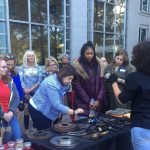
Because She Can – Patrice Banks
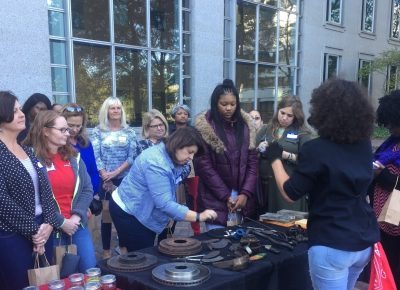
Patrice Banks gave up her six-figure income occupation to start up the Girls Auto Clinic, an auto repair shop run by and for women. Women can get the car fixed and have their nails done while they wait.
This piece appeared in the December 2017 issue of JerseyMan magazine. You can read it on their website here, or click here to see the PDF from that issue.
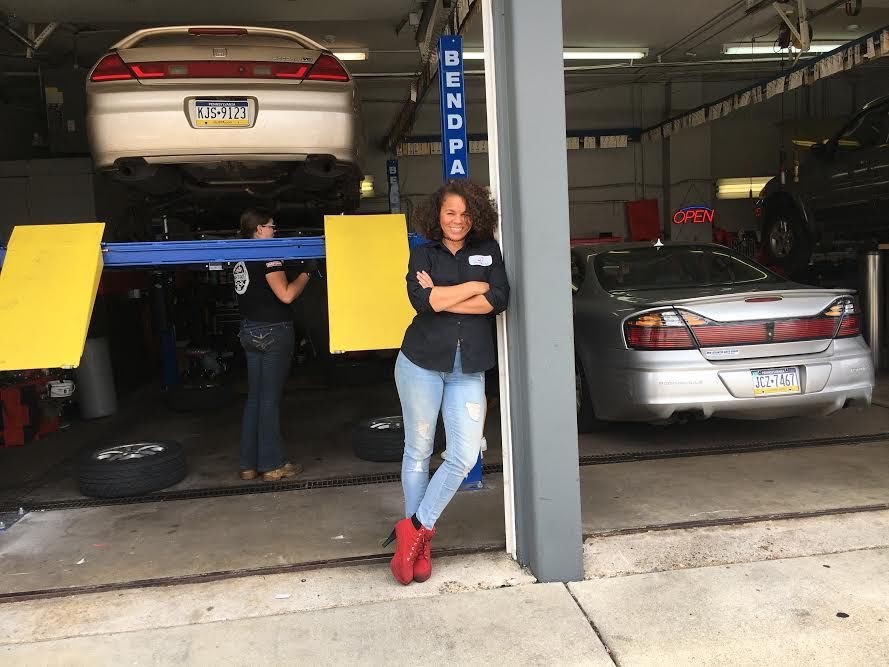
The attractive and savvy Patrice Banks at her auto repair shop.
(Photo courtesy of Patrice Banks)
Because She Can
Patrice Banks, owner of Girls Auto Clinic in Upper Darby, is smashing a conventional wisdom held for generations…that women can’t understand cars.
As we guys know, our women can be astoundingly forgiving sorts. We see it an awful lot with our leaders’ wives. We screw up regularly, and they not only put up with it, they’ll even show support for us in public.
But take advantage of a Philly girl one too many times, and one day she’ll open up an industrial-sized can of whoop-ass on you.
For example, imagine an entire industry neglecting a demographic worth $200 billion a year. That’s how much the fairer sex spends buying automobiles and repairing them. And yet in a 2013 RepairPal survey, two-thirds of them believed they were overcharged for repairs simply because they are women.
Patrice Banks, owner of the Girls Auto Clinic and Clutch Beauty Salon in Upper Darby, knows the feeling. As a former “auto airhead”, she spent much of her adult life dreading—and sometimes dangerously postponing—trips to mechanics for oil changes and repairs. Like much of her gender since the dawn of automobiles, her lack of car knowledge caused her to zone out whenever a mechanic explained a repair. And yes, she has stories about being ripped off.
One day a wormhole opened. Banks suddenly decided to answer a simple question that no one had answered in over a century: Why are females so intimidated by the workings of an automobile?
Answering the question turned into a lifetime mission…to finally answer to the needs of that $200 billion demographic.
At Girls Auto Clinic, women can get their car serviced…and have their nails done as they wait. Nearly all her employees, including the mechanics, are women. The store is popular enough to have a 4.9 rating in 188 Facebook reviews. Banks also hosts popular and free workshops, and maintains a blog on auto repair and maintenance.
She also managed to publish a 300-page book breaking down and explaining cars, titled the Girls Auto Clinic Glove Box Guide. The book openly states that it’s a necessary component of a well-stocked glove compartment. Boastful? Maybe. But in the book, the blog and her workshops, with her simple explanations of why cars need oil changes and what crankshafts do, Banks makes the point throughout: this stuff isn’t that hard. If a former auto airhead can teach it, anyone can learn it.

The former auto airhead is now a teacher.
(photo courtesy of Patrice Banks)
If she only desired financial success, giving up a lucrative career and sinking one’s life savings into an untested business model would be an odd route. It’s female independence that drives Patrice Banks.
As the daughter of a single mother—who, as Banks puts mildly, made poor life choices—she saw first hand the need for women to be self-sufficient.
“I didn’t have an empowered mother, which is crazy, because I was always an empowered girl. I always wanted to prove that women could do anything men could do,” she says. “I believed I was bigger than my surroundings. I didn’t want to become my mother. So I was always funneling my extra time into positive things, schoolwork, sports, having jobs.
“My mom didn’t know how to drive, she took the bus to work. I had to ask people for rides home, and I hated being dependent on others. And that has a lot to do with why I’m very self-reliant.”
In her desire for a better life, she toiled for a degree in Materials Engineering from Lehigh University. From there she spent 12 years as a failure analyst and manager at DuPont, where she was pulling down six figures. In other words, she made enough money to buy new cars solely to minimize trips to a mechanic.
In her spare time, she started a blog called “Banks On It”, dedicated to teaching women to do things they generally paid or asked men to do…such as fixing toilets or investing money. As she mined for ideas, she asked every woman she knew what they needed help with the most.
The overwhelming response? Wait for it…“Cars.”
Banks searched for a female mechanic in the area to help her explain automobiles…and came up empty. It was, she says, her “light bulb moment”. The well-paid engineer decided to become a mechanic herself.
She spent evenings earning an Automotive Technology diploma from Delaware Technical Community College. During that time, she offered to work as a mechanic for free…and was turned down at several shops, for reasons like “the boss’s wife won’t like it.” Once she became familiar with the not-so-complicated inner workings of automobiles, she opened her own shop.
Judging from the exposure she’s gotten since, including appearances on Fox & Friends, CBS This Morning, and O Magazine, it sounds like she’s onto something.
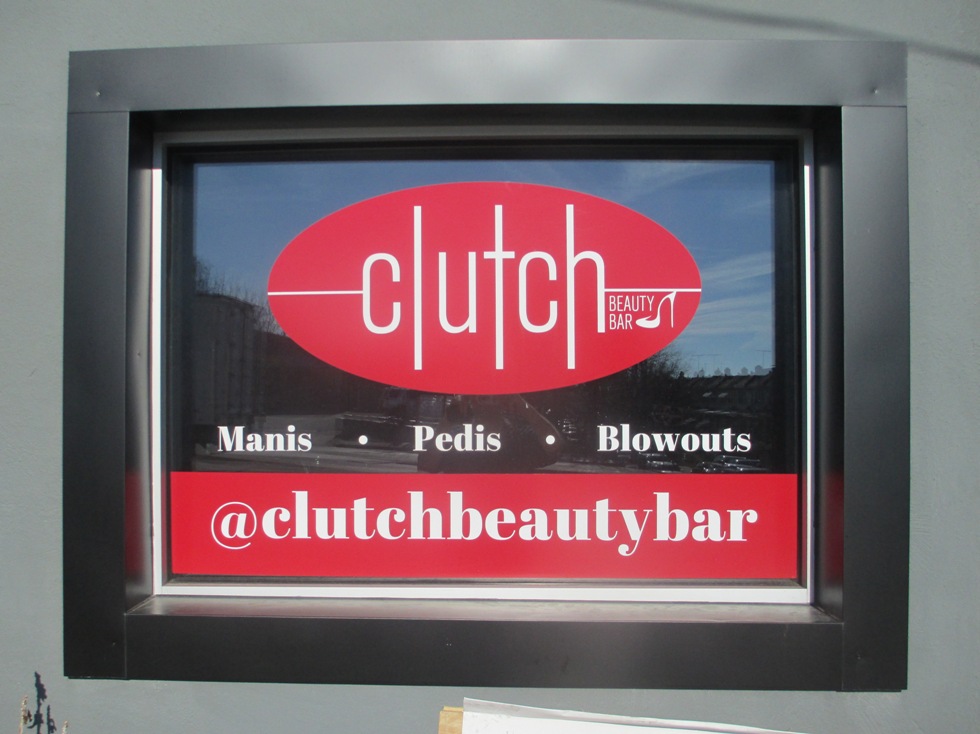
The salon right next door, for hair and nails while you wait.
As Banks wrote in a Washington Post op-ed, 2% of the nation’s auto mechanics are women, and just 13% of car salespeople are women. She drove home the point: “it’s easy for us to feel misunderstood and mistreated by the auto business when we don’t see ourselves reflected in it.”
“We need to have more women in the industry that we can interface with, that we can talk to about our cars,” she says. “Women would rather deal with a woman because we know what they go through. We have women that come from miles away, they don’t even care about our certifications, they trust us to work on their cars because we’re women. That’s how bad it is.”
As an example, she cites unnecessary “upsells” like filters and flushes that shops peddle to less car-savvy customers. “They do need to be done, but they only need to be done at certain times. You don’t need an air filter every oil change, you need one maybe every other oil change.”
She unequivocally states that it’s ingrained. “It’s become this culture, because of the way that the business model is set up. I see people being told they need new brakes when they don’t. I see that all the time. When I went back to school, I realized what’s really necessary. We’re not going to upsell, we’re going to offer you a fair price.”
And if you’re marketing to women, it doesn’t hurt to have a beauty salon as a waiting area. The Clutch Beauty Bar is humorously auto-themed, with toolboxes at each station and a sink constructed from a wheel. It’s a place where women can get “manis, pedis, and blowouts” as their oil is being changed.
The customers love it. As Lorie “Lulu” Tisdell gets her toenails painted, she gushes excitedly about GAC, pointing out the toolboxes and hanging extension cords in the salon and sharing her story about finding the place during a snowstorm. Lulu has been a loyal devotee since the beginning.
Even more so, Banks’s employees are appreciative. As Colleen McClure works the front desk taking calls and speaking with customers, she shares how she worked for years at a hydraulic shop and turned wrenches at other independent repair shops. She offers a simple explanation why she quit: “I was treated like s***.”
It’s an obvious business model. But an industry that spends millions coming up with car names like “Probe” and “Cruze” somehow missed it.

Patrice with her book, an easy, enjoyable read.
(photo courtesy of Patrice Banks)
It’s actually difficult to imagine Patrice Banks having difficulty persuading a man to fix her car. She is easily personable, bubbly but never overbearingly so, and decidedly easy on the eyes.
Away from a camera or microphone, her humility stands out far more than her trademark spunk. She can even be seen decorating a Christmas tree in the shop. “I always look forward to decorating until I’m actually doing it, then I realize this is hard work,” she jokes. When talking with Patrice, one never gets the impression that she considers herself superior.
Which, when you think about it, makes her a perfect fit to appeal to a demographic whose pet peeve is feeling condescended to by mechanics and salesmen.
Ask her what her proudest achievement is and it’s not being featured in Oprah’s magazine or on national TV. It’s her success in what she set out to do…help women in an arena where they have been neglected, and given the amount of money they spend, profoundly underappreciated. There have been difficulties, to be sure, but Patrice Banks has no doubt that this is what she was born to do.
“With any startups, you make a lot of mistakes that cost you a lot of money. Everyone will. I tell people, I fail every day, and I look forward to it, because it gets me closer to winning. Small businesses make dumb mistakes, big businesses make dumb mistakes and it costs them millions. I’d rather make them now when I’m small.”
There is nothing small about the impact Patrice has had on her employees especially. “Since my shop opened, my mechanics have come to me and said this was the best paying job they’ve ever had. And that makes me feel good, to be paying women well, to help their families, particularly in a profession that they’ve struggled in and been kicked out of.
“That to me is my greatest accomplishment, and I’m grateful.”
Did this post make your day a little bit?
I hope so. If it did, I would really appreciate your support.
When you use this link to shop on Amazon, you’ll help subsidize this great website…at no extra charge to you.
Thanks very much…come back soon!
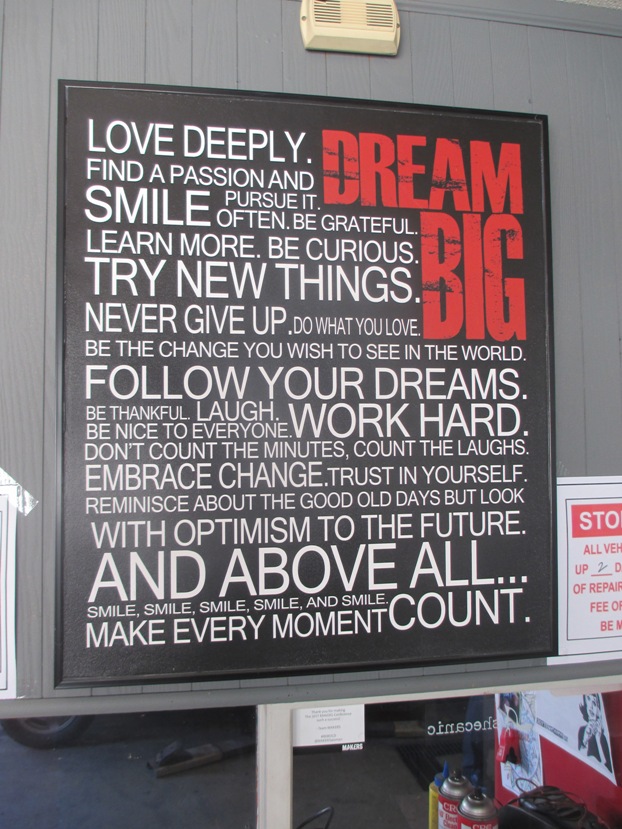
It’s actually all common sense when you think about it.
You Turned Down Who?
Despite that every day she has to ensure that customers keep coming to the shop, Patrice Banks has turned down opportunities for publicity that struggling entrepreneurs would die for. Imagine rejecting offers to appear with Rachael Ray or Ryan Seacrest, or even a chance to show America your business on “Shark Tank”. But she’s learned that national exposure isn’t always a good thing.
“Press isn’t always cracked up to what you think it is,” she explains. “And one of the reasons is that there’s too much content. Everyone’s looking for content. I would be excited at this network coverage, and they would do the story and I would be on TV, but all I have is my shop, I can’t reach someone in California. So it wasn’t translating into sales.
“We were having people come here and shoot all day, five or six hours, but some people would like my page and that was it. I couldn’t convert it into buyers. It started to become a distraction, because I had nothing to sell to a national audience. People would want me to franchise, and I just can’t yet. It wasn’t an advantage, because I wasn’t prepared for it.
“Rachael Ray and Ryan Seacrest, they all wanted to have me on before my book came out. The problem I have now is, now that I have a book to sell, the old press are saying, well, we’ve already done a story on you. And new press is saying, well they did a story on you.
“But you don’t know these things starting out. You’re all like, it’s great, and you can talk about it, but you realize that’s not always the best way to go about it.”
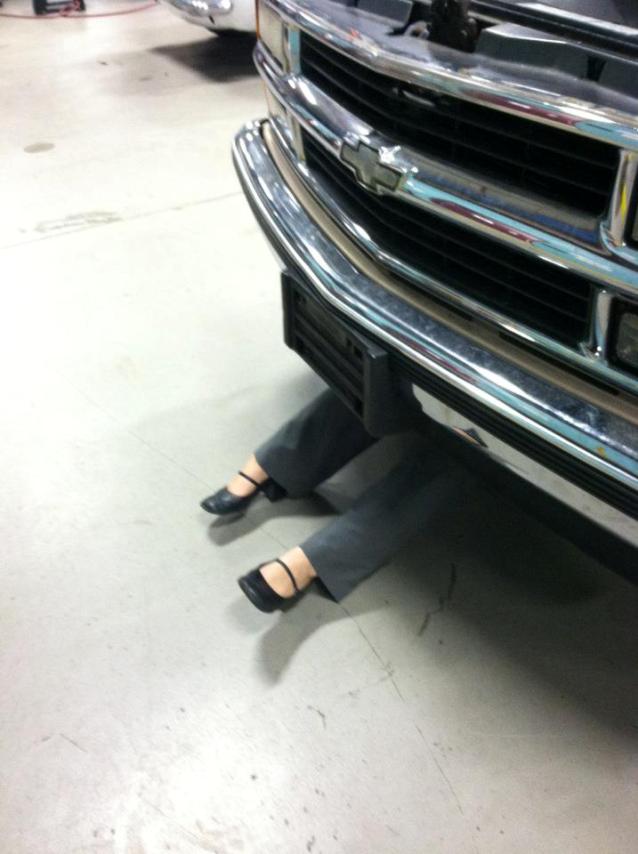
The trademark heels.
What is a #SheCANic?
Part of Patrice Banks’ dedication to helping females is by turning them into “#sheCANics”. The term, in her words, describes “a female of any age who has mastered the mechanics of ‘yes I can’ and uses them to get to ‘yes I did.’
On the #sheCANic page of the Girls Auto Clinic website, women can read a blog full of car tips, find out when and where Patrice will be giving her next workshop, or join a Facebook community of over 9,000 members where they can have their car questions answered.
The blog is full of posts directed at women…with titles like “Alternators Are Like Cell Phone Chargers…” or “Does Your Car Have Boogies?” But they are ultimately serious and simply explained posts designed both to help women take better care of their cars and also to realize that these things are easy to understand.
The #sheCANic logo includes the red heel, a part of Banks’ signature look that happened by accident. “I had to go right from work to school,” she told Oxygen.com. “At work I wore slacks and heels. At school we had to wear dirty clothes, so I mixed them up. One day I was under a car pulling out a starter, and someone took a picture of my heels sticking out. It was perfect.”
Incidentally, no, Patrice doesn’t work on cars with her heels on. Nor, she says in her book, does she recommend doing so.








